
E-mail: font@focusonnature.com
Phone: Toll-free in USA 1-888-721-3555
or 302/529-1876
www.focusonnature.com
 |
PO
Box 9021, Wilmington, DE 19809, USA E-mail: font@focusonnature.com Phone: Toll-free in USA 1-888-721-3555 or 302/529-1876 www.focusonnature.com |
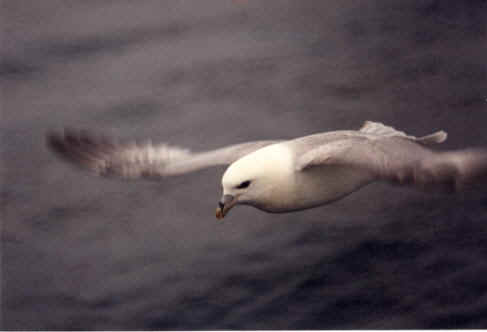 A
List of Birds
A
List of Birds
in
Iceland
Noting those found during
Focus On Nature Tours
1996 thru 2015
Those with an
(*) found during FONT tours,
with the months in red indicating when seen
during FONT tours.
There have been 20 FONT tours in Iceland.
They have been during the months of
May, June, September, and October.
This list and text compiled and
written by Armas Hill
There are 386 species of birds in this list,
one of which, the Great Auk, is extinct.
Codes:
(ICr): rare in Iceland
(ph): with a photo here in the FONT website
Links within this List:
Icelandic Breeding Birds Waterfowl (Swan, Geese, Ducks) Divers (or Loons)
Raptors Waders (or Shorebirds) Skuas, Gulls, Tern Alcids Owl Passerines
Former Icelandic Breeding Birds including the Great Auk and the Water Rail
Common Migrants in Iceland Geese Waders Gull Alcid Thrushes (Turdus)
Uncommon
to Rare Visitors to Iceland
Waterfowl
Heron Coot
Waders (Shorebirds)
Skuas, Gulls
Pigeons,
Doves Owls a Swift
Passerine Birds
Vagrants in Iceland Quail Waterfowl Divers, Albatross, Storm-Petrel, Grebes
Storks, Spoonbill, Ibis Bitterns, Herons, Egrets Raptors Crakes & Allies, Cranes
Waders Gulls & Terns Doves Cuckoos Owl, Nightjar, Nighthawk Swift
Woodpeckers Tyrant Flycatchers Shrikes Vireo Swallows Old World Warblers
Kinglet, Nuthatch Starling Thrushes Chats & Old World Flycatchers Pipits & Wagtails
Finches New World Warblers New World Orioles & Blackbirds Sparrows & Buntings
Other Links:
Upcoming
FONT Birding & Nature Tours in Iceland Upcoming FONT
Tours Elsewhere
List
of Birds found during previous FONT Iceland Tours
A List & Photo Gallery of European Birds, in 2 Parts:
Part #1: Grouse to Puffins Part #2: Sandgrouse to
Buntings
Iceland Marine Life Iceland Wildflowers and some Other Plants
FONT Past Tour Highlights Photo Galleries & Narratives from past FONT tours
Directory of Photos in the FONT Website
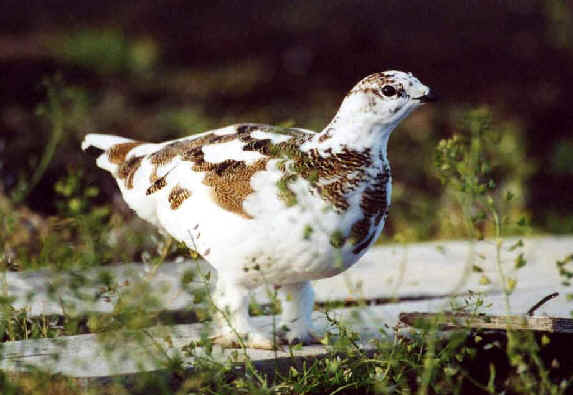
A Rock Ptarmigan photographed
during a FONT tour in Iceland
during the month of October
(photo by Alan Brady)
1. Rock Ptarmigan (ph) (*)
May Jun Oct
Lagopus mutus
The Rock Ptarmigan breeds in Iceland in heathland, copses,
scrubby areas, and well-vegetated lava fields, from the seashore to the
mountains. In the mountains, they occur only rarely higher than the vegetation
line.
In the autumn, birds from lower elevations head for the mountains, with adults
doing so first as the summer wanes, and young birds following later. By the
beginning of October, the majority of Icelandic Ptarmigans have arrived
at their winter feeding grounds in the mountains, when they can find shelter
against the weather by burying themselves in the snow, particularly on more
protected slopes. At times, however, when snow and ice cover the ground, the
birds are forced to seek food in the lowlands - on hillsides, in scrub, and
even, at times, in towns and villages.
In Iceland, Ptarmigans are most common in Pineevjarsysla, in the northern
part of the country.
The Rock Ptarmigan population in Iceland fluctuates in 10-year cycles.
The maximum may be ten times the minimum population.
The Rock Ptarmigan has a circumpolar population, with as many as 27
subspecies.
The subspecies of the Rock Ptarmigan in Iceland is Lagopus
mutus islandorum. That of Greenland, Lagopus
mutus captus, has also been found in Iceland. It is slightly larger
than the Icelandic subspecies, and has white patches in the
primaries.
In the winter, when there is snow on the ground, both sexes of the Rock
Ptarmigan are almost entirely white. In the summer, when the earth is bare,
the birds are brown. Thus they have a year-round protective coat against
predators. However, the male remains white longer than the female, until late in
the spring. Even though the summer plumage of both sexes begins to appear at the
end of April, just the female fully attains that brown plumage by the end of
May, when she starts to incubate the eggs.
The male Ptarmigan does not attain its full summer plumage until late in
June. From late-April to mid-June, when the males are actively flaunting
themselves, and courting females and claiming and defending nesting territories,
they are quite conspicuous and an easier prey for predators such as the
Gyrfalcon. It is estimated that as many as a third of male Ptarmigans
during that time of year fall prey. But this high mortality does not have an
impact on the overall Ptarmigan population, as the new birds of the year
are incubated and reared by the females, and the young males move into
territories of fallen predecessors.
The Rock Ptarmigan is the only Icelandic bird to live all year almost
entirely on plant food. Young Ptarmigan chicks feed to a certain extent
on insects, but adults feed almost exclusively on foliage, flowers, and berries
during the summer, and on buds and stalks in the winter.
The chicks feed on then insects as they need energy-rich food in order to grow
quickly. When the young are about 4 weeks of age, they become independent of
their mother.
Male Rock Ptarmigans vocalize with sounds that are dry and cackling,
whose those of females are repetitively cackling.
The legs of the Rock Ptarmigan are short and feathered. They are also
powerful. The bird is a good walker, and it runs well.
Rock Ptarmigans fly fast and low with rapid wingbeats. They glide with
curved wings.
Ptarmigan hunting was formerly a professional occupation in Iceland. In
the late 1920s, about 250,000 birds were exported annually. In accordance with
present legislation, however, the hunting of Ptarmigan is only permitted
between October 15 and December 22, and it is now just an amateur sport, and not
a way of making a living.
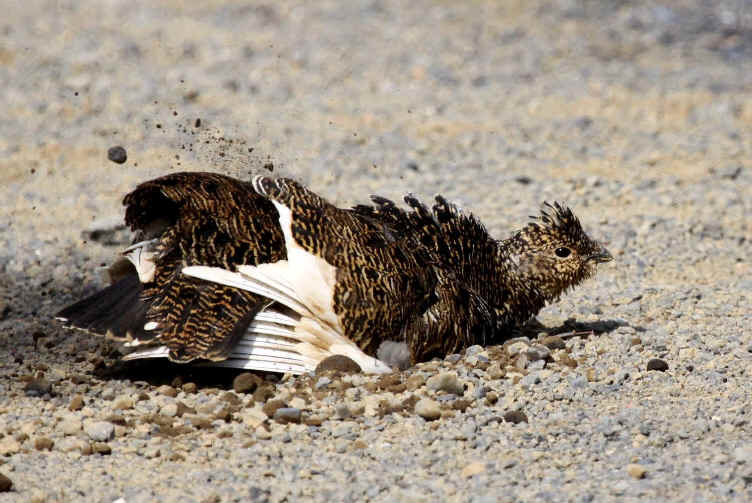
A Rock Ptarmigan doing a
"dust bath",
photographed during the FONT Iceland Tour in June 2015
(photo by Marie Gardner)
WATERFOWL
2. Whooper Swan (ph) (*) May
Jun Sep Oct
Cygnus cygnus
The Whooper Swan is the largest Icelandic bird. The cob is a
bit heavier than the pen. The species is common throughout Iceland, both in the
highlands and lowlands.
In October, there are an estimated 10,000 to 11,000 Whooper Swans in
Iceland, with just under 20 per cent of them immature birds. Thus, the total
number of adult swans being about 8,600.
Most of the Whooper Swans of Iceland are migratory, with most wintering
in the British Isles, the majority in Ireland.
A few hundred stay in Iceland as year-round residents, haunting fresh water
rivers and lakes in the winter that remain relatively free of ice. If (or when)
the weather worsens, they move to the coast and dwell in shallow bays and firths
where there are large ebb-tides and large amounts of eelgrass, their favorite
food that time of year.
Those that migrate return to their nesting sites as soon as the ice melts on the
lakes, but breeding does not begin until the latter part of May.
Whooper Swans nest dispersively, with usually only 1 breeding pair per
lake or tract of sedge, although there can be more nests by larger lakes with
greater
vegetation.

An adult Whooper Swan with 3 cygnets during the FONT
Iceland Tour in June 2012
(photo by Gabriel Hauser)
3. Greylag Goose (ph) (*) May
Jun Sep Oct
Anser anser
Unusual, but the "Eastern Greylag Goose", Anser
anser rubrirostris, has occurred in Iceland.
4. Pink-footed Goose (ph) (*) Jun
Sep Oct
Anser brachyrhynchus
In Iceland, the Pink-footed Goose nests mainly in the
highlands, whereas the Greylag Goose does so in the lowlands.
But in recent years, as the population of the Pink-footed Goose has been
increasing, nesters have been spreading down large river valleys and elsewhere
in the lowlands. Some nesting locations are used year after year. Preferred
breeding areas are upland marshy areas, or on the banks of rivers and lakes.
Nests are on a tussock or some other prominent place.
The main breeding locale of the Pink-footed Goose in Iceland is the
Pjorsaver, where there is one of the largest goose colonies in the world. An
estimated 10,000 pairs of Pink-footed Geese breed there. There are
another 2,000 or so breeding pairs at smaller nesting sites elsewhere in the
central highlands.
Additionally, another 4,000 non-breeding Pink-footed Geese dwell in the
highlands of Iceland in the latter part of the summer, also chiefly at
Pjorsarver.
Note: the numbers just indicated in this paragraph have probably increased in
recent years.
Pink-footed Geese also breed in eastern Greenland, and those birds travel
in Iceland as migrants in the spring and autumn.
The total Pink-footed Goose population of Iceland and Greenland combined
in the autumn has grown ten-fold during recent decades, from about 23,000 birds
in 1952 to 230,000 birds in 1995. These birds winter in northern England and
Scotland. They depart from Iceland during October.
A separate population breeds on Svalbard. Those birds winter from Denmark to
Belgium.
The Pink-footed Goose has a high-pitched call, somewhat
shrill.

Pink-footed Geese during the FONT Iceland Tour in June 2012.
Above: an adult with its pink feet. Below: a gosling.
(photos by Gabriel Hauser)
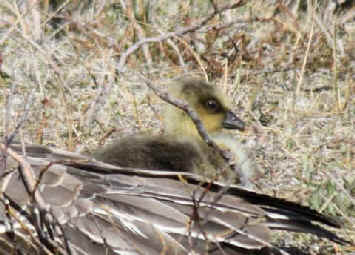
Below, a group of Pink-footed Geese
during the FONT Iceland Tour in June 2015
(photo by Marie Gardner)
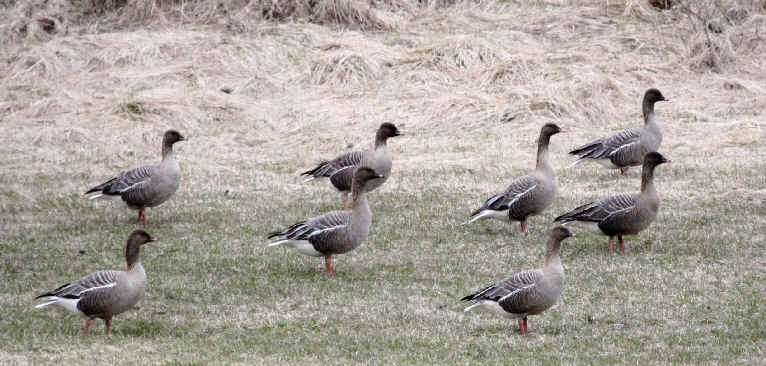
5. Common Shelduck (ICr) (*) Jun
Tadorna tadorna
The Common Shelduck was a vagrant in Iceland until 1990, when
it first bred.
It has bred almost annually since, in Borgarfjordur in western
Iceland, and Eyjafjordur in northern Iceland (where the first breeding
occurred).
Numbers, which have been
5 to 10 pairs annually, have been rising.
In southern Iceland, Common Shelducks have been seen now (in 2015) for
about 10 years, by the Olfusa Rover in Selfoss.
11 Common Shelducks arrived in Hofn, on the southeast Iceland coast, on
March 15, 2015. Two arrived at Selfoss on March 7, 2015.
Most Icelandic birds seem to be migrants, but their wintering areas are not
known. Some have been occasionally seen in Iceland in the winter. Nesting sites
in Iceland have been in or under outhouses and summer cabins.
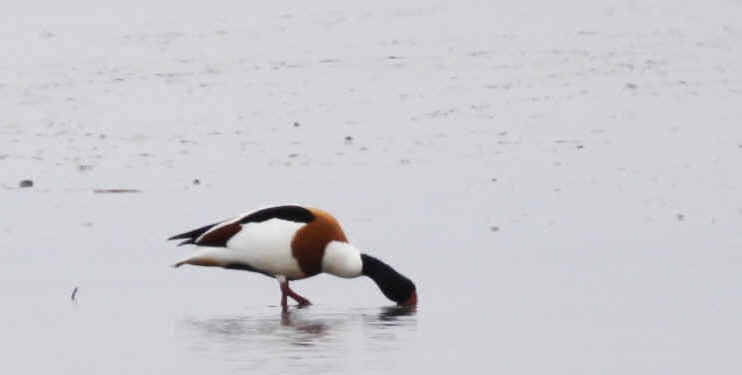
A Common Shelduck feeding on a tidal mudflat, as
that species often does.
This was the first Common Shelduck seen during a FONT tour in Iceland,
in June 2015.
(photo by Marie Gardner)
6. Mallard (ph) (*) May Jun
Sep Oct
Anas platyphynchos
7. Gadwall (ph) (*) Jun Oct
Anas strepera
8. Northern Pintail (ph) (*) Jun
Anas acuta
9. Eurasian Wigeon (ph) (*) May
Jun Sep Oct
Anas penelope
10. Eurasian Teal (ph) (*) May
Jun Sep Oct
Anas crecca
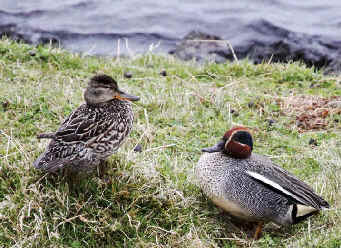
A pair of Eurasian Teal during
the FONT Iceland Tour in June 2015
(photo by Marie Gardner)
11. Northern Shoveler (ph)
Anas clypeata
12. Tufted Duck (ph) (*) May
Jun Sep Oct
Aythya fuligula
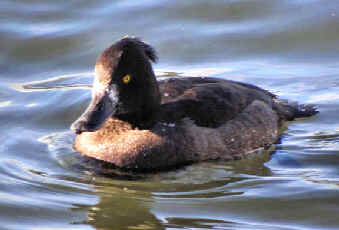
A female Tufted Duck during the FONT Iceland Tour in Sep/Oct 2013
(photo by Alan Mitchnick)
13. Greater Scaup (*) Jun Oct
Aythya marila
14. Barrow's Goldeneye (ph) (*) Jun
Sep Oct
Bucephala islandica
The main breeding area of the Barrow's Goldeneye is in the
northern part of North America.
The Barrow's Goldeneye is one of three
species of birds in Iceland that are more "American" than
"European". The other two are the Harlequin Duck and the Common
Loon. The Red Phalarope, with a small number nesting in Iceland, can
also be added to that category. As could have been the Great Auk, now
extinct, that bred more in North America than in Europe.
Also, the Barrow's Goldeneye is said to be a very rare breeding bird in
western Greenland. But aside from that, Iceland is the only place where the Barrow's
Goldeneye breeds in Europe. It has occurred as a vagrant in continental
Europe and the in the Faeroe Islands, with those birds probably having come from
Iceland.
The population of the Barrow's Goldeneye in Iceland seems to have
remained quite stable over the years, at about 800 pairs.
Barrow's Goldeneyes nest naturally in holes and in crevices in lava, as
well as in ready-prepared boxes and even in outhouses or in the stone walls of
buildings. In Icelandic, it has thus been called the "house-duck".
The nest of the Barrow's Goldeneye is lined with down.
The principal breeding locations in Iceland are at Lake Myvatn, a large
eutrophic lake, and by the nearby Laxa River, in the northeastern part of the
island. Elsewhere in the country, there are just a few pairs.
The Barrow's Goldeneye winters at or near the nesting places, and on
unfrozen lakes and along rivers in southern Iceland, notably the Sog River,
where sometimes the species can be seen in the late-spring and
summer.
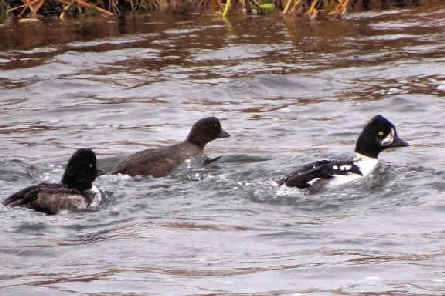
Barrow's Goldeneyes photographed during the FONT Iceland Tour in Sep/Oct 2013.
(photo by Alan Mitchnick)
15. Long-tailed Duck (t3) (ph) (*) May
Jun Sep Oct
Clangula hyemalis

Above & below: a
male Long-tailed Duck in breeding plumage
during the FONT Iceland Tour in June 2015
(photos by Marie Gardner)
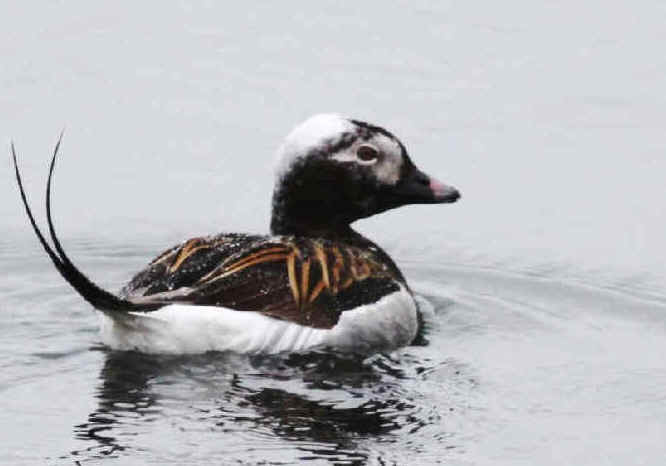
16. Harlequin Duck (ph) (*) May
Jun Sep Oct
Histrionicus
histrionicus
In Europe, the Harlequin breeds, and regularly occurs, only in
Iceland and Greenland. Otherwise, the species breeds in northeast Canada,
western North America, northeast Siberia, and northern Japan.
The Harlequin population in Iceland is not very large, estimated as being
from 2,000 to 3,000 pairs.
In the summer, it is distributed throughout the country, including the central
highlands. Icelandic birds are resident on the island. They winter all around
the coastline, especially where it is steep and rocky, and where the sea tends
to be rough.
They occur in small groups, and they are fond of being in the surf. In Iceland,
the Harlequin is referred to as the "surf-duck".
An area of Iceland with numerous Harlequins in the winter is the
Reykjanes Peninsula, along the south and west coasts.
In April, Icelandic Harlequins enter bays and firths and gather in groups
in river estuaries. In May, they undertake a journey, sometimes lengthy, up the
rivers to where they will breed. Their prime nesting areas are where
fast-flowing rivers exit lakes that are rich in vegetation and animal life - for
example, the Laxa River near lake Myvatn. Harlequins during their
breeding season live mostly on animal food such as gnat larvae and pupae.
As the summer progresses, Harlequins remain on the rivers with their
young until they are fully fledged. In September, they all depart for the coast.
It is after they arrive there that they moult.
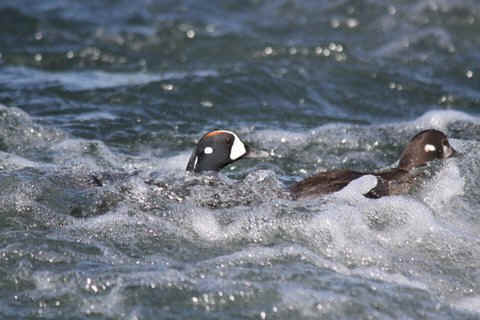
Above: a pair of Harlequin Ducks in the rushing
water of a river in Iceland
Below: a female Harlequin Duck with young
The only place where this species normally occurs in Europe is Iceland.
(upper photo by Gabriel Hauser; lower photo by
Howard Eskin)
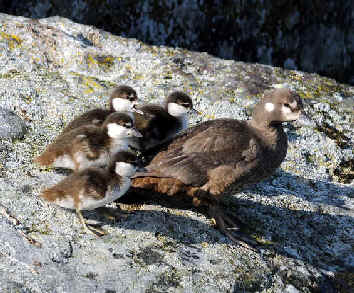
17. Common Scoter (*) May Jun Sep
Oct
Melanitta nigra
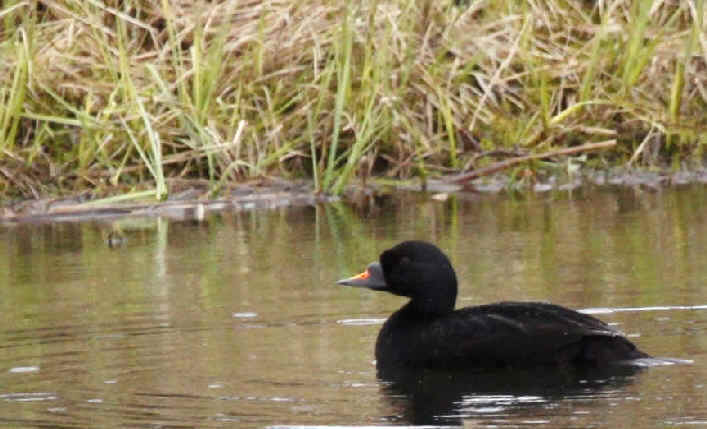
A male Common Scoter during
the FONT Iceland Tour in June 2015
in an area where the species nests.
(photo by Marie Gardner)
18. Common Eider (ph) (*) May
Jun Sep Oct
Somateria mollissima
It is in the autumn that Common Eiders are most numerous in
Iceland. During that season, there are at least half a million of them.
In the fall, 100,000 to 200,000 drakes moult on Faxafloi Bay in southwest
Iceland. Some birds that breed in eastern Greenland winter, and probably moult,
in Iceland,
Common Eiders are generally on or near the ocean, during both the
breeding and non-breeding seasons. A few do breed by rivers and lakes up to
about 20 kilometers from the sea.
Common Eiders eat only marine organisms, but their diet can vary at
different times of the year. A duck and her chicks, in shallow waters, feed
mostly on sand hoppers. As winter progresses, Common Eiders feed on
capelin, congregating at the capelin's spawning grounds to eat the roe. Common
Eiders also gather in fishing harbors to feed on fish waste.
Throughout Icelandic history, the Common Eider has been utilized by man,
and it still is today. In earlier times, the flesh and eggs of the bird were
considered more valuable than its down. But now in Iceland the Eider
is a protected bird, and the down is the product that matters. Each bird,
as it molts, provides about 17 grams of pure down every year, adding up to a
national total in Iceland of about 2,000 kilograms per year, and this providing
income for the approximately 250 eider breeding ground owners. The eider-farmers
collect the down only sparingly while the duck and her chicks are still
in the nest. The remainder of it is taken once the birds have left for the
sea.
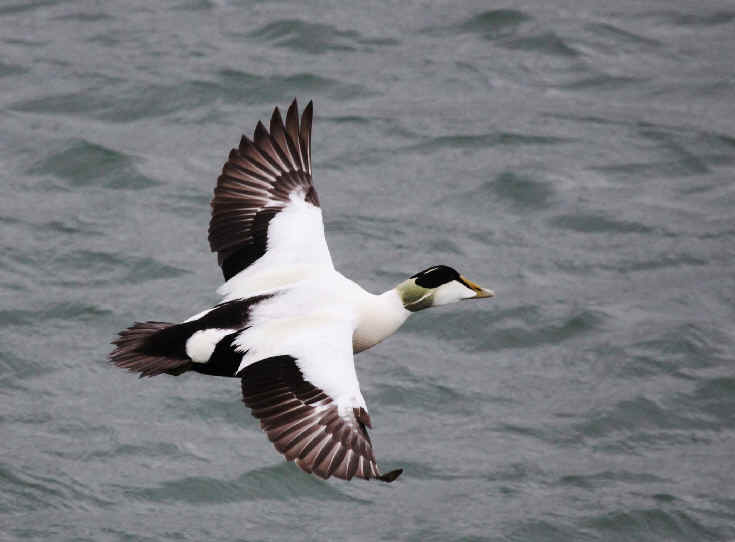
Above
and below: male Common Eiders
Above: in flight, during the FONT Iceland Tour in June 2015.
Below: during the FONT
Iceland Tour in Sep/Oct 2013.
Notice in the lower photo, the greenish and pinkish colors
in the bird's breeding plumage.
(upper photo by Marie Gardner,
lower photo by Alan Mitchnick)
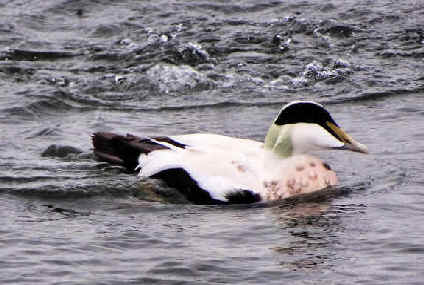
19. Common Merganser (or Goosander) (ph) (*)
May Jun Sep Oct
Mergus merganser
20. Red-breasted Merganser (ph) (*)
May Jun Sep Oct
Mergus serrator
DIVERS (or LOONS)
21. Red-throated Loon (or
Red-throated Diver) (ph) (*)
May Jun Sep Oct
Gavia stellata
The Red-throated Loon, or Red-throated Diver, with its
gray neck and head and burgundy throat, is about two-thirds the size of the
Common Loon, or Great Northern Diver.
It occurs throughout Iceland, especially in the lowlands. It nests mostly by
lakes and ponds, and occasionally by calm rivers.
Unlike the Common Loon, the Red-throated Loon often nests by small lakes
surrounded by rushes and without fish. in such cases, it finds its food in other
nearby lakes, or even out at sea flying considerable distances to do so. Red-throated
Loons and Common Loons rarely breed by the same lake.
The Red-throated Loon breeds in northern countries all around the world.
Most that nest in Iceland are migratory, wintering along the coasts of western
Europe.

A Red-throated Loon during the FONT Iceland Tour in June
2012.
In Europe (where Iceland is), the English name for the species is Red-throated
Diver.
(photo by Gabriel Hauser)
22. Common Loon (or Great Northern Diver)
(ph) (*) May Jun Sep Oct
Gavia immer
Globally, the main area for the Common Loon, or Great Northern
Diver, as a breeder is the northern part of North America. Elsewhere, it nests in Iceland. It also has nested in Greenland and on
Bear island near Svalbard, but nowhere else in Europe.
Birds from Iceland either winter off the coast of western Europe, including
Britain and Ireland, or off the coast of Iceland.
There is a maximum of about 300 nesting pairs of Common Loons in Iceland,
where the species is widely distributed. It prefers large, deep, trout-filled
lakes in remote moors and mountains. The species normally does not nest at lakes
without fish, or where there is a large amount of vegetation, or where there is
teeming birdlife. Unless a lake is quite large, there generally is only 1
breeding pair of Common Loons on a body of water.
Common Loons arrive at their nesting sites as soon as the ice melts on
the lakes. They lay their eggs either in late May or early June. By late August
or September, they usually are out at sea.

A Common Loon during the FONT Iceland Tour in June
2012.
in Europe (where Iceland is), the English name for the species is Great Northern
Diver.
(photo by Gabriel Hauser)
23. Northern Fulmar (ph) (*) May Jun
Sep Oct
Fulmarus glacialis
The marked increase, and spread, in the population of the Northern
Fulmar in the North Atlantic during the last 200 years has been well
documented. It is written that there was a single colony in Iceland in 1640.
That is almost unbelievable. It is one of the most common species in Iceland
today throughout the coastal regions of the country.
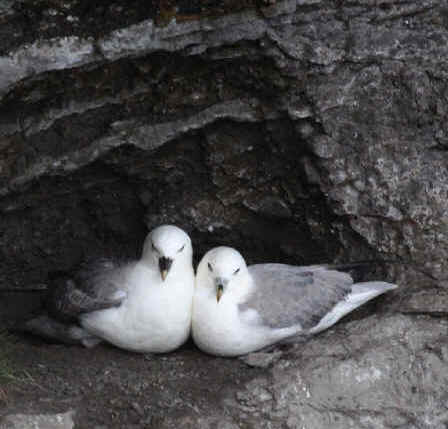
A pair of Northern Fulmars at
a cliffside nest,
photographed during the FONT Iceland Tour in June 2015.
(photo by Marie Gardner)
24. Manx Shearwater (*) Jun
Puffinus puffinus
From 8 to 10 thousand pairs of Manx
Shearwaters nest during the summer in Iceland, particularly on the Westmann
Islands, off the southern coast. The bird can be seen offshore at various places
off the southern and southwestern coasts of Iceland from the spring to autumn.
During the Northern Winter, the Manx Shearwater is in the South Atlantic,
particularly off southern South America, occurring in numbers off the coast of
Argentina.
When at sea, Manx Shearwaters feed mostly on small pelagic fish. When
they come back from the sea to their nests, the parent Manx Shearwaters
feed their chicks regurgitated fish and fish oil, The chicks soon grow
fat.
Manx Shearwaters in Iceland often gather in flocks, doing so often in the
evenings during the late summer. Such flocks can be seen on the sea around the
Vestmannaeyjar (the Westmann Islands).
.
25. European Storm-Petrel
Hydrobates pelagicus
An estimated 100,000 pairs of European Storm Petrels nest in
Iceland. The largest Icelandic colony is on Ellidaey island, in the Westman
Island group, off the southern coast of the country. There are also colonies on
two other islands in the Westmanns, as well as on Ingolfshofdi off southern
Iceland, and on Skrudur Island off eastern Iceland. The species also nests in
Europe in the Faeroe islands, the British Isles, and coastally south to the
Mediterranean.
In the autumn, the European Storm Petrel heads toward the South Atlantic
Ocean, wintering as far south as the coast of South Africa.
In their nesting colonies, European Storm Petrels prefer to nest under
stones, among boulders, or in rocky crevices.
During the day, by colonies of European Storm Petrels and those of the
following species, the Leach's Storm Petrel, one would hardly be aware of
the birds at their nesting areas, but during the Icelandic short night of
summer, in the darkness, suddenly there are swarms of them flying back and forth
to sea.
In a storm petrel nesting colony, of either of these two species, if a
person were to put his or her ear next to the cracks and crevices, he or she
would hear a purring sound from the sitting birds, not unlike the purring of a
contented cat.
The European Storm Petrel is not much bigger than a Snow
Bunting.
26. Leach's Storm-Petrel (*) Jun
Oceandroma leucorhoa
Maybe as many as 150,000 pairs of Leach's Storm Petrels nest
in Iceland. The world's largest populations of what has been the Leach's Storm
Petrel (there are various widespread subspecies) are in Newfoundland,
Canada, and at various places in the Pacific Ocean. The species is rare in
Europe.
The largest European colony of the Leach's Storm Petrel is on Ellidaey
island in the Westmann Islands, off southern Iceland, It also nests on most
islands of the archipelago where Atlantic Puffins do. Leach's Storm
Petrels sometimes nest at the bottom of a deep burrow, In Iceland, they are
known to make a burrow further out from that of a Puffin. Sometimes Leach's
Storm Petrels nest among boulders, but usually they make nesting burrows in
grass or turf, as do Manx Shearwaters.
Additional nesting locations for Leach's Storm Petrels in Iceland also
include Ingolfshofoi in the south, and perhaps Skrudur Island in the east. The
species winters in the South Atlantic Ocean.
The Leach's Storm Petrel is similar in size to a
Starling.
On April 10, 2011, a Leach's
Storm Petrel was found, blown inland, by Highway 1 about 15 kilometers east
of Selfoss.
GREBES
27. Horned Grebe (or Slavonian Grebe)
(ph)
(*) Jun Oct
Podiceps auritus
The Horned Grebe, or the Slavonian Grebe as its called
in Europe, is an attractive and colorful bird in breeding plumage, as it is in
Iceland in the spring and summer. It is the only bird that nests in Iceland with
a nest that floats. That nest is made of rotting marsh vegetation, and often is
situated in thick swathes of sedges and rushes. The base of the nest is attached
to surrounding plants so that it does not get swept away, and it can rise or
fall with any change in water level.
In Iceland, the bird is most common as a nester at Lake Myvatn, where there are
about 250 breeding pairs. It is also rather common elsewhere in the northeastern
part of the island and in Skagafjordur. Now, however, it rarely breeds elsewhere
in the country. The total nesting population in Iceland is estimated at about
500 pairs.
The Horned Grebe in Iceland is mostly migratory. It arrives at its
nesting areas in April, just as the ice has melted on the lakes. Departure from
the breeding grounds is in late September or October. A few remain off the
southwestern coast of Iceland all winter, but many of the Icelandic breeding
birds winter off the coasts of western Europe.
At lakes where they breed, Horned Grebes eat insects such as water
beetles and midge larvae. When at sea, during the winter, they feed mostly on
small fish and crustaceans.
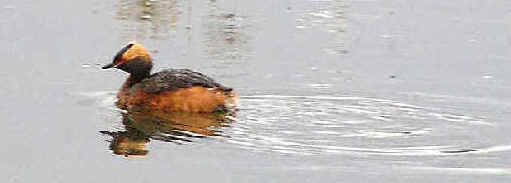
A Horned Grebe photographed during a FONT tour in
Iceland.
That tour was in the late spring, as the bird was in breeding plumage.
In Europe (where Iceland is), the English name for the species is Slavonian
Grebe.
(photo by Cheryl Pearce)
CORMORANTS, GANNET
28. European Shag (ph) (*) May
Jun Sep Oct
Leucocarbo aristotelis
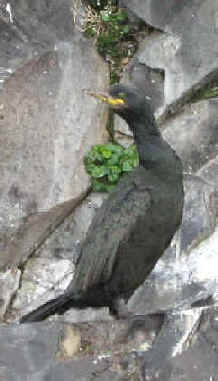
A European Shag photographed during a FONT tour in Iceland.
If you look very closely, you'll see that the bird has green eyes.
29. Great Cormorant (*) May Jun
Sep Oct
Phalacrocorax carbo
30. Northern Gannet (ph) (*) Jun
Sep Oct
Morus bassanus
The breeding grounds of the large, striking seabird, the Northern
Gannet, are on both the western and eastern sides of the North Atlantic
Ocean.
In Iceland, there are now 8 colonies of Northern Gannets. Four
of them, in southern Iceland, are on outer isles in the Westmann Islands:
Sulnasker, Geldungur, Hellisey, and Brandur. Other colonies are at Raudinupur on
Melrakkasletta, on the Langanes Peninsula, and on the Isle of Skrudur, offshore
from Faskrudsfjordur. Some of these Icelandic colonies are new since the
1940s.
Conversely, one colony, in northern Iceland, on Grimsey Island, became extinct
in 1946.
But it is on Eldey Island, about 14 kilometers southwest of the Reykjanes
Peninsula, in southern Iceland, where there is the largest gannet colony in the
country. It is the third largest gannet colony in the world, after those at St.
Kilda and Grassholm in the British Isles. About 60 per cent of the 25,000
nesting pairs of Northern Gannets in Iceland occur at Eldey.
In the Icelandic language, a name for the Northern Gannet refers to it as
the ""Queen of the Atlantic"". That name is derived from the
gracefulness of the bird in flight.
The Northern Gannet is a swimmer and a diver. It dives, with folded
wings, from as high as 150 feet in the air, entering the water at a tremendous
speed. But it does not stay underwater long, rarely for more than 6 seconds. Nor
does it go deeply, usually to 10 feet or so under the surface.
Northern Gannets generally depart Iceland from October to December. Those
that bred in Iceland have been observed in the winter from the west coast of
mainland Europe south to West Africa.
RAPTORS
31. White-tailed Eagle (ph) (*) May
Jun Sep Oct
Haliaeetus albicilla
The White-tailed Eagle is the rarest and the largest of the 3
species of raptors that normally occur in Iceland. The female is notably larger
and heavier than the male. The bill of the bird is large and thick. The legs are
big and powerful. The talons are grooved to enable it to grasp slippery fish in
its claws. The White-tailed Eagle is one of eight related species in the
world referred to as "sea-eagles".
The White-tailed Eagle does not attain its plumage as a full adult until
it is 6 years old. A juvenile is much darker than an adult. At 3 years of age,
the head becomes lighter in color and the middle tail feathers become white. By
the 4th year, the whole tail is almost white. During its 5th year, the bird
closely resembles the adult eagle.
The White-tailed Eagle existed in Iceland long before people settled
there, but the birds were not common. It is thought that the maximum number of White-tailed
Eagles on the island would have been between 200 and 300 pairs, and it is
possible that there were never more than 100 to 200 pairs. The species
historically occurred throughout Iceland, but more so in the western part of the
island.
There was a sudden decline in the White-tailed Eagle population in
Iceland in the late 19th Century, during an era when birds of prey in Europe
were persecuted, and there was even an attempt to exterminate the eagle
in Iceland. Some people, particularly farmers, were pleased with the sharp
decrease in the number of eagles.
Others thought that the demise of the White-tailed Eagle would be
regrettable. So, in 1913 a law was passed to protect it in Iceland - that law
was to be effect for 5 years. It was then renewed for another 20 years. And,
now, to this day, it has never been repealed. Thus the White-tailed Eagle
has been a protected species in Iceland since 1913, and thus saved from
extinction in the country.
However, through most of the years of the 20th Century, the population of
Icelandic White-tailed Eagles remained low. In the summer of 1959 it was
thought that there were 38 White-tailed Eagles still in existence in
Iceland. Since then, the population of the species has been under annual
surveillance by the Icelandic Society for the Protection of Birds. In 1964,
another law was enacted forbidding the poisoning of carcasses in order to kill
Arctic Foxes. It had become known that young eagles also died from eating such
poisoned carrion. It is now estimated that there are 35 to 40 adult pairs of White-tailed
Eagles in Iceland and additional juvenile birds.
The nest of the White-tailed Eagle in Iceland is unpretentious, often
only a hollow in vegetation lined with a bit or moss or seaweed. Adult eagles,
that mate for life, have territories that are generally very extensive. Eagle
pairs do not necessarily the same eyrie each year. Actually some pairs
change nests frequently. But the birds often establish a nocturnal roosting
place, usually not too far from the nest, to which they remain faithful, using
it both in and out of the breeding season. In Iceland, adult eagles rarely visit
a nest from October through December.
Globally, the White-tailed Eagle is distributed from western
Greenland east across Europe and Asia to the Pacific.
In Europe, the White-tailed Eagle is classified as "rare",
although since the 1960s it has been recovering after its critically low-level
resulting from persecution and environmental contamination. Today, the
European country with the most White-tailed Eagles is Norway
with 1,500 pairs, followed by Poland with about 200 pairs, and Greenland with
from 150 to 175 pairs.
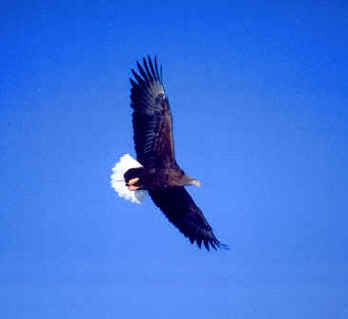
An adult White-tailed Eagle photographed during a FONT tour
32. Gyrfalcon (ph) (*) May Jun
Oct
Falco rusticolus
The Gyrfalcon is the largest of the world's falcons. There is
a notable difference in size between the sexes, with the female being larger.
The male weighs about 1200 grams. The female weighs about 1800 grams.
In old literature, naturalists wrote about white, gray, and black "color
phases or morphs" of Gyrfalcons, and even about "different
species" of Gyrs. Actually, the different plumage types grade
imperceptibly into one another, with an array of intermediate forms being
found.
Generally, the High Arctic breeders in Greenland and the Canadian Arctic islands
are mostly white (the candicans type). White birds occur less frequently
in the Low Arctic regions, and they are not found at all as breeders in Iceland,
where the resident population consists mostly of light gray individuals (the islandus
type), nor in Scandinavia and Russian Arctic, where the Gyrs are
mostly dark gray to bluish gray (the gyrfalco type).
White Gyrfalcons do occur in eastern Siberia, in the Bering Sea region,
in western Alaska, and to a limited extent on the Arctic Slope of Alaska, but
not at all in subarctic breeding populations.
Black Gyrs (the labradorus type described by Audubon) are most
common in Quebec and Labrador, and are occasionally encountered across the
American Arctic. The Ungava region of northern Quebec is especially interesting,
as the whitest and blackest types breed together in the same areas along with a
number of birds with an intermediate gray coloration.
The Gyrfalcon in Iceland has a grayish back and a pale, somewhat
yellowish breast with brown streaks and spots. The young birds are white at
first, but they quickly darken. In fact, the immature Gyrfalcons are
considerably darker than adults. The talons of immature Gyrfalcons are
bluish. Those of adults are bright yellow.
Gryfalcons in Iceland are year-round residents on the island. The
population is estimated as being from 200 to 400 pairs. The Gyrfalcon population
fluctuates with the Ptarmigan population. Gryfalcons are most
common in Iceland in the northern part of the country, particularly in
Pingeyjarsysla, and in Vestfirdir.
A few decades ago, an Icelandic student studied the population of Gyrfalcons
in his country. He tabulated data from about 200 nests. During good Ptarmigan
years, he figured that there were from 300 to 400 nesting pairs of Gyrfalcons
throughout Iceland. In his study area of 2,000 square miles, there were at least
35 cliffs occupied by Gyrfalcons. In that area, 24 pairs produced about
70 young, even though Ptarmigan that year were not especially numerous. With an
area of 33,500 square miles, excluding glaciers, it can be said that Iceland has
the densest regional population of Gyrfalcons in the world, with
approximately one pair per 60 to 115 square miles.
In nearby Greenland, the size of the Gyrfalcon population is highly
uncertain, with maybe from 500 to 1,000 pairs. Gyrfalcons that spend much
of the year along both of the coasts of Greenland have been found to migrate, on
occasion, in the winter from those coasts, out over the sea southeast to Iceland
and southwest into the Canadian
Arctic.
In the population of Gyrfalcons that are resident in Iceland, pairs often
change nesting sites from year to year, but they stay within the breeding
territory that they established, and to which they remain loyal for years. Pairs
of Gyrfalcons can remain on their territories all year, both in and out
of their breeding season.
The nests of Gyrfalcons are usually at places that are difficult or
impossible to reach, as on the rocky cliffs of mountains and river canyons. The
breeding season begins early in the spring, usually in April. The young birds
are fully fledged by mid-July, after 6 to 7 weeks in the nest. After fledging,
they remain near the nest for another month or so, and the parents continue to
bring food to them until they more proficiently hunt food for themselves. Once
they are self-sufficient, the birds range over a large area. In Iceland,
juvenile birds fly throughout the country, and are apt to be found at the
seashore in mid-winter.
During the nesting season, the female Gyrfalcon incubates the eggs and
later tends to the young, while the male provides food for the family and
guards the nest from a nearby vantage point.
In Iceland, Gyrfalcons that nest near the coast prey upon a large number
of seabirds, particularly Puffins. In the country overall, the Ptarmigan
is the Gyrfalcon's most important prey during the spring and summer.
Gyrfalcons feed mostly on male Ptarmigans during the spring when the grouse
are such easy targets, being white against a dark background. When those
Ptarmigan attain their darker plumage, Gyrfalcons may prey more upon
birds of other species, such as shorebirds, ducks and geese and their young, and
also newly fledged Ptarmigans. Gyrfalcons can seize their prey both
on the ground and in the air.
During a recent study of Gyrfalcons in northeastern Iceland, it was found
that Ptarmigans constituted about 80 per cent of the prey of the Gyrs of
the heathland, not just in the spring and summer, but all year.
Historically, the Gyrfalcon was exported from Iceland for falconry, but
more recently there has been a determination that the bird's status as a
protected bird is to be respected. The Gyrfalcon has had that status in
Iceland, as a protected species, since 1940. it is illegal to approach or
photograph a Gyrfalcon nest without the permission of the Icelandic
government (the Ministry of Education and Culture).
33. Merlin (ph) (*) Jun
Sep Oct
Falco columbarius
The Merlin is both the smallest and the most numerous of the
birds of prey in Iceland. The population, of from 500 to 1,000 pairs, is
classified as an endemic subspecies, Falco columbarius
subaesalon. It nests dispersively throughout the country.
The Merlins that breed in Iceland are mainly migratory. The majority
leave the country in September and October for their wintering quarters in the
British Isles and western Europe. A few, however, spend the winter in Iceland.
The Merlin preys on birds not much smaller than they are, including: Snow
Buntings, Meadow Pipits, Wheatears, and Redwings. It even, on occasion, has been
known to prey on birds that are larger, such as: Golden Plovers and Redshanks.
It is also known to prey on young of other species: Ptarmigans, Whimbrel, and
various ducks.
Merlins are cunning and daring, with no shortage of stamina. As fliers,
they are very agile.
Unusually, but the "American Merlin", Falco
columbarius columbarius, has occurred in Iceland.
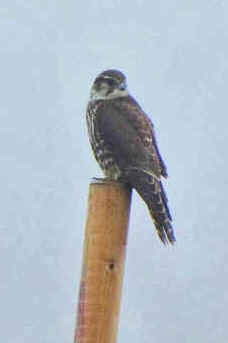
A Merlin photographed in Iceland during FONT
tour in Sep/Oct 2013.
(photo by Alan Mitchnick)
WADERS (or SHOREBIRDS)
34. Eurasian Oystercatcher (ph) (*) May
Jun Sep Oct
Haematopus ostralegus
Since around 1920, when the climate of Iceland began a warming
trend, that has continued, the number of Eurasian Oystercatchers in
Iceland has greatly increased. It is now a common breeding bird in southern and
western Iceland. A number of birds, particularly in that part of the country,
have become resident, remaining in Iceland all year. Those that migrate from
Iceland winter in great Britain. Birds in northern and eastern Iceland are
generally migratory.

Above & below: Eurasian Oystercatchers, an adult
and one very young,
photographed during the FONT Iceland Tour in June 2012
(photos by Gabriel Hauser)
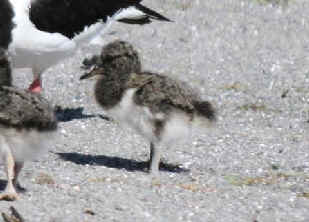
35. European Golden Plover (ph) (*) May
Jun Sep Oct
Pluvialis apricaria
The European Golden Plover is a common breeding bird in
Iceland, especially on moors, highland heaths, and stony hills where there is
some vegetation.
This species, that nests in Iceland, is migratory, wintering in the British
Isles or mainland western Europe. It departs from Iceland in October, although
occasionally some are seen in Iceland during the winter.
More than any other Icelandic bird, the European Golden Plover is
regarded as a harbinger of spring, with its arrival being a symbolic marking of
the beginning of that season. The characteristic plaintive song of the plover
captures the hearts of the people in the Icelandic countryside.
The fluting call that is heard in April, as the days are lengthening, is an
indicator that soon flowers will be blooming again. And so, the European
Golden Plover has become an integral part of the Icelandic folklore, and has
inspired poets for centuries.
A typical poem begins:
"The plover has come, bid farewell to the snow!
Its song will dismiss all boredom and gloom.
It tells me the whimbrel is soon to follow,
the sun will start shine, and the flowers will bloom."
The European Golden Plover is a completely protected bird in
Iceland.
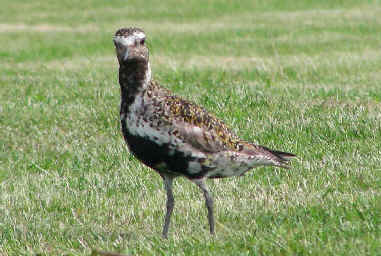
A European Golden Plover photographed during the
FONT Iceland Tour in June 2009
(photo by Gerin Hood)
36. Common Ringed Plover (ph) (*) May
Jun Sep Oct
Charadrius hiaticula
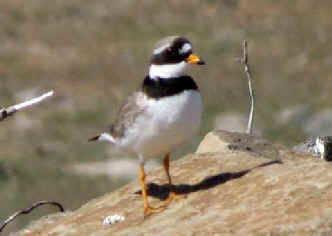
A Common Ringed Plover photographed during the FONT Iceland Tour in June 2012
(photo by Gabriel Hauser)
37. "Eurasian" Whimbrel (*) May
Jun
Numenius phaeopus
The Whimbrel, common in the Icelandic lowlands in the summer,
is one of the most familiar birds to people in the country. It is not so much
its plumage that attracts their attention, although its long curved bill is
certainly noticeable. Rather, it is the bird's distinct and easily recognizable
call, a melodious fluting trill, that people know as a characteristic sound of
summer.
Whimbrels in Iceland are migratory. They arrive in early May. After
nesting, there are signs as early as mid-July that birds are readying themselves
to depart. They begin to fly about restlessly in small flocks. These flocks,
through the summer, become larger, and the birds often fly in formation. Then,
during nights in August, especially around midnight, a distinctive departure
call can be heard from flocks of Whimbrels on the wing as they leave
Iceland, embarking on a long journey over the open sea. A few birds linger into
September. But by the end of that month, all have departed for wintering
grounds, chiefly in western Africa.
When on their nesting territories, Whimbrels defend them tenaciously. If
a predatory bird enters the area, a flock of Whimbrels will try to drive
away the uninvited guest. Ravens, White-tailed Eagles, Gyrfalcons, Merlins,
Short-eared Owls, Great Black-backed Gulls and Parasitic Jaegers can expect such
a hostile reception.
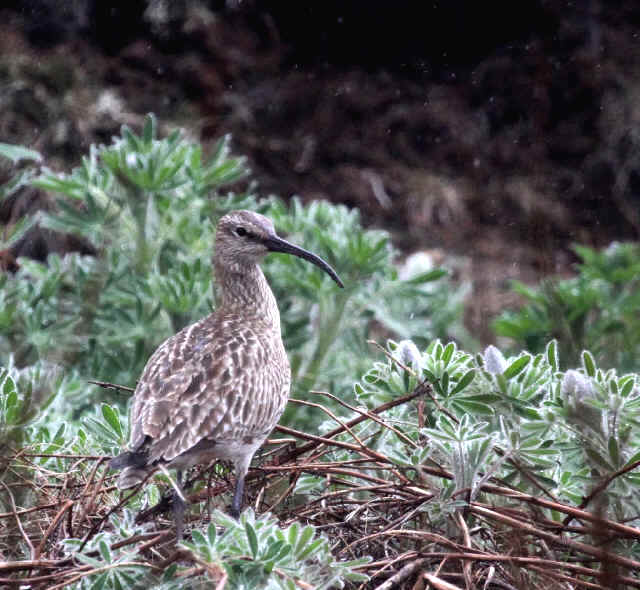
A "Eurasian"
Whimbrel
photographed during the FONT Iceland Tour in June 2015
(photo by Marie Gardner)
38. Black-tailed Godwit (ph) (*) May
Jun Sep Oct
Limosa limosa
At the beginning of the 20th Century, the Black-tailed Godwit
bred in Iceland only in the southern lowlands, and it rarely occurred elsewhere
in the country. Now, it breeds throughout Iceland, with as many as 10,000 pairs,
which is almost certainly a result of a warmer climate.
It is rather interesting that the Black-tailed Godwit breeds in Iceland
at all, as it is generally a more southerly species, not breeding even in
Britain or Scandinavia. Iceland is the northernmost nesting location for the
species.
The Black-tailed Godwits in Iceland are a unique subspecies, Limosa
limosa islandica. Its distinguishing features are a shorter bill and
a stronger red coloration than that of the subspecies of mainland Europe.
In September, the bird departs Iceland for its winter home along the coasts of
western Europe, as far south as Portugal. Most Icelandic birds winter in
Ireland. The birds return to Iceland in late April.

A Black-tailed Godwit photographed during the FONT
Iceland Tour in June 2012
(photo by Gabriel Hauser)
39. Common Redshank (ph) (*) May Jun
Sep Oct
Tringa totanus
The Common Redshank is widespread in Iceland. Its choice
habitats are shallow ponds, and lakeside and bogland mud-banks, particularly in
the lowlands.
The majority of the 50,000-plus Redshanks that nest in Iceland are
migratory. Those that migrate winter in the British Isles. Several hundred
Redshanks winter along the coast of southwestern Iceland.
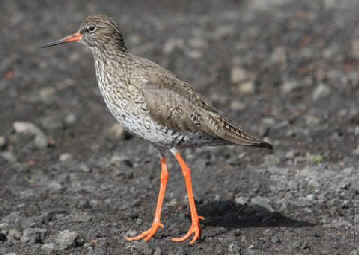
A Common Redshank photographed during the FONT Iceland Tour in June 2012
(photo by Gabriel Hauser)
40. Dunlin (ph) (*) May Jun Sep
Oct
Calidris alpina
41. Purple Sandpiper (ph) (*) May
Jun Sep Oct
Calidris maritima
The Purple Sandpiper is a common breeding bird in the
highlands of Iceland, with from 20,000 to 30,000 pairs.
The breeding season is in late May and early June. There are usually 4 eggs in
the simple nest. The young leave the nest soon after they are hatched, and the
male parent takes care of them. The young become fully fledged at 3 weeks of
age. At the end of July or the beginning of August, the adult male and the young
leave the nesting area for the coast, where the female adults already gathered
some time previously.
Outside the breeding season, Purple Sandpipers occur in groups along the
seashore, haunting shingle-beaches, mudflats, and sands where they feed on
various small animals such as snails, mussels, and acorn barnacles. During the
summer, in the mountains, they had fed on various insects, flies, midges, and
their larvae.
During the winter, the Purple Sandpiper is the most common shorebird in
Iceland, and it is the only shorebird, that time of year, that is regularly
observed in northern and eastern Iceland.
Some of the Icelandic breeding population winters in the British Isles. Others
seemingly spend the winter in Iceland.
Some Purple Sandpipers that breed in areas in the Arctic, north of
Iceland, pass through the country in the spring and autumn, while some of those
birds apparently stay in Iceland through the winter.
In the circumpolar Arctic region, Purple Sandpipers breed in the Atlantic
part of the Arctic Ocean area, on Greenland and other islands, and also in
northern Eurasia from Scandinavia east to Siberia.
42. Eurasian Woodcock
Scolopx rusticola
The Eurasian Woodcock is generally a rare bird in Iceland, said now
to be a breeder. It occurs in ditches and by open small streams, often adjacent
to shrubs. It also occurs in geothermal areas.
43. Common Snipe (ph) (*) May Jun
Sep Oct
Gallinago gallinago
In the summer, the Common Snipe is a common bird in the
Icelandic lowlands. It is less common in the highlands. The favored habitats are
bogs and fens.
Most Icelandic Snipe are migratory, arriving in Iceland in April and
remaining in the country until late in the autumn. A few winter in southern and
southwestern Iceland, often staying close to brooks and springs that remain
unfrozen.
The migrants from Iceland spend the winter in Ireland.
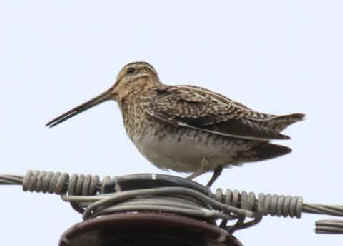
A Common Snipe photographed during the FONT
Iceland Tour in June 2012.
At that time of year, and especially late in the day, Snipes are heard winnowing
in the Icelandic sky
seemingly "everywhere" and continuously.
This one had just alit atop a utility pole after doing its aerial display.
(photo by Gabriel Hauser)
44. Red-necked Phalarope (ph) (*) May
Jun
Phalaropus lobatus
The Red-necked Phalarope is an attractive species in its
summer plumage. It is widespread and common during that season throughout the
Icelandic countryside, occurring in wet areas especially in the lowlands, but
also in the highlands. From 30,000 to 40,000 pairs nest in Iceland.
These birds are completely migratory. They have been thought to winter in the
South Atlantic Ocean, off the coast of Africa, but now Icelandic breeding birds
are believed to winter on the Arabian Sea.
Red-necked Phalaropes spend only a short time in Iceland. They arrive
along the coast in late April and early may, and enter their breeding
territories in mid-May. In the mid and late summer, they go back to the coast,
and then depart from Iceland in August or September.
When at their breeding sites, Red-necked Phalaropes are tame, often
allowing an observer to approach closely.
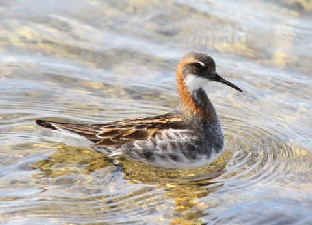
A Red-necked Phalarope in a pool in a small town
during the FONT Iceland Tour in June 2012
(photo by Gabriel Hauser)
45. Red (or Grey) Phalarope (ICr) (*)
Jun
Phalaropus fulicarius
The Red Phalarope is an Arctic bird. It breeds so dispersively
in Iceland that its exact number is not known. But there are probably not more
than a hundred birds in total throughout the country. It breeds mostly in
coastal areas and on small islands. As a bird uncommonly seen, the nests of the
species in Iceland are hard to find.
In recent years, known nesting sites in Iceland have been abandoned, possibly
because of a warmer climate and human interference.
The Red Phalarope (or Grey Phalarope, as it is called elsewhere in
Europe) is migratory. It arrives in Iceland rather late (the latest arrival of
all the Icelandic breeders), not before May 20. Nesting begins in early June,
and by the end of July all have generally left their breeding grounds, going to
coastal waters where they remain until September.
Red Phalaropes of Iceland are believed to spend the Northern winter (or
Southern summer) on the far-southern Atlantic
Ocean.
SKUAS, GULLS, TERN
46. Parasitic Jaeger (or Arctic Skua) (ph) (*)
May Jun
Stercorarius parasiticus
The Parasitic Jaeger (or Arctic Skua, as it is called
in Europe) is common throughout Iceland in the summer, especially in the
lowlands and valleys. It nests on moors, bogs, and, in southern Iceland, on
sands. It generally does not occur at elevations higher than 2,000 feet above
sea level.
Icelandic Parasitic Jaegers are completely migratory. They arrive from
mid-April to mid-May, usually before the Arctic Tern. It leaves the country at
about the same time as the Arctic Tern, in late August, although a few birds
linger into the first week of September.
Outside the breeding season, the Parasitic Jaeger is an oceanic bird.
The population from Iceland is believed to winter in the southern part of the
Atlantic.
Parasitic Jaegers occur in two plumages which bear no relation to either
sex or age: the dark form (uniformly blackish-brown) and the light (with white
underparts). Sometimes birds of the two forms are at the same nest. It is
estimated that about 30 per cent of the Icelandic Parasitic Jaegers are
of the dark form.
A method used by Parasitic Jaegers to obtain food is to rob other birds
of theirs by chasing them until they drop their catch from their bills. In
Iceland, often Arctic Terns, Kittiwakes, Puffins, and Fulmars are subjected to
that harassment. Other ways that Parasitic Jaegers procure food are to
steal eggs, kill smaller birds, and feed on carrion and waste. Once in a while, Parasitic
Jaegers are seen feeding on crowberries and bilberries.
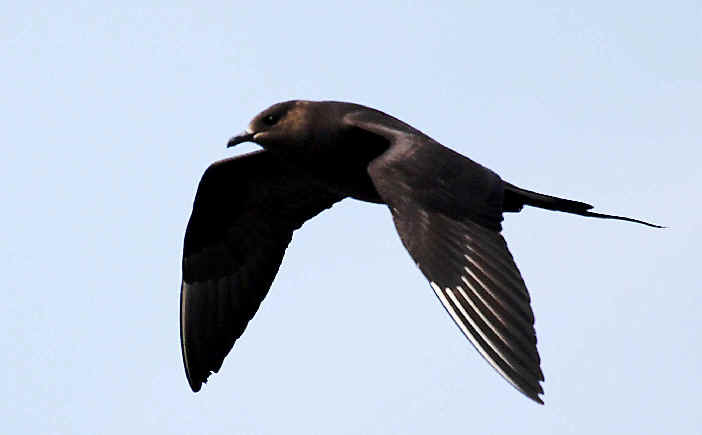
A dark morph of the Parasitic Jaeger,
or as it is known in Europe, the Arctic Skua,
during the FONT Iceland Tour in June 2015
(photo by Marie Gardner)
47. Great Skua (ph) (*) May
Jun Sep
Stercorarius
(formerly Catharacta) skua
About half of the Great Skuas in the world breed in Iceland.
Other breeding places for the species include the Shetland, the Orkneys, and the
Faroes.
There are an estimated 5,000 to 6,000 breeding pairs of Great Skuas in
Iceland. Apart from a few scattered nesting sites elsewhere, its distribution in
Iceland is on the great sands along the southern coast. The nests are usually
not close to each other as the breeding territories of the pairs are large.
The Great Skua is a large bird that is fierce and aggressive at its
nesting site. It winters at
sea.
Fishing activity has been said to have influenced the Icelandic
population of Great Skuas. It increased until about 1930, and then there
was a marked decline until the 1960s, when the population stabilized.
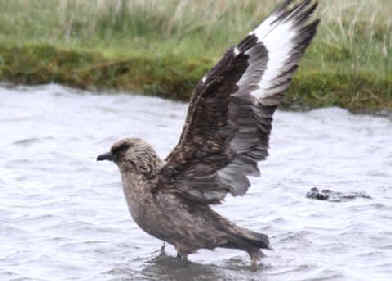
A Great Skua bathing in a roadside pool, not far
from the sea,
during the FONT Iceland Tour in June 2012
(photo by Gabriel Hauser)
48. Black-headed Gull (ph) (*) May
Jun Sep Oct
Chroicocephalus
(formerly
Larus)
ridibundus
The Black-headed Gull has had a marked increase and spread in
northwest Europe since the early 19th Century. It colonized in a number of
countries since 1800, and in Iceland actually after 1900, first occurring there
in 1911. It did not increase in numbers in Iceland until after 1930,
concurrently with an increase in the population in the Faeroe Islands.
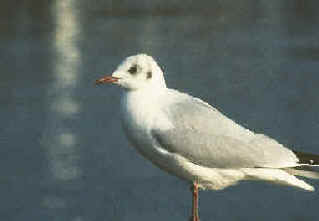
Above and below:
Black-headed Gulls
Above: non-breeding plumage,
Below: in breeding plumage
(both photos by Armas Hill)
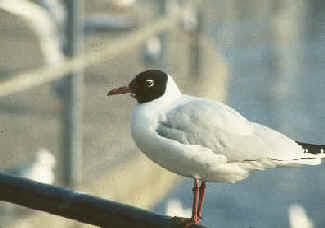
49. Common Gull (or Mew Gull) (*) May
Jun Sep Oct
Larus canus
The Common Gull probably bred for the first time in Iceland
around 1936.
50. Glaucous Gull (ph) (*) May Jun
Sep Oct
Larus hyperboreus
The most Glaucous Gulls in Europe are in Iceland, where the
population has been stable after a marked decline in the early 20th Century.
51. "European" Herring Gull (*) May
Jun Sep Oct
Larus argentatus
52. Lesser Black-backed Gull (ph) (*) May
Jun Sep Oct
Larus fuscus
The Lesser Black-backed Gull first bred in Iceland in the
1920s. It subsequently spread, mostly north and west, and increased to about
10,000 pairs in 1970.
Since the early 1900s, the Lesser Black-backed Gull has had a
remarkable population increase and range expansion in northwest Europe,
not just in Iceland, but also in Britain and Ireland, with
more than ever also appearing in Greenland, Canada, and the United
States.
In Greenland, breeding Lesser Black-backed Gulls were confirmed,
for the first time, in 1990. Now, it breeds abundantly for the first time
in southwestern Greenland.
The total number of Lesser Black-backed Gull pairs in south Greenland in 2003
was about 600. But the area has not been surveyed systematically, and so there
may be more. Elsewhere, near Nunk, there have been at least an additional 100
pairs. So, a conservative estimate is at least 700 pairs.
In Iceland, Lesser Black-backed Gulls are often found nesting at
places not favored by other gull species. Such places are barren, lava
fields.
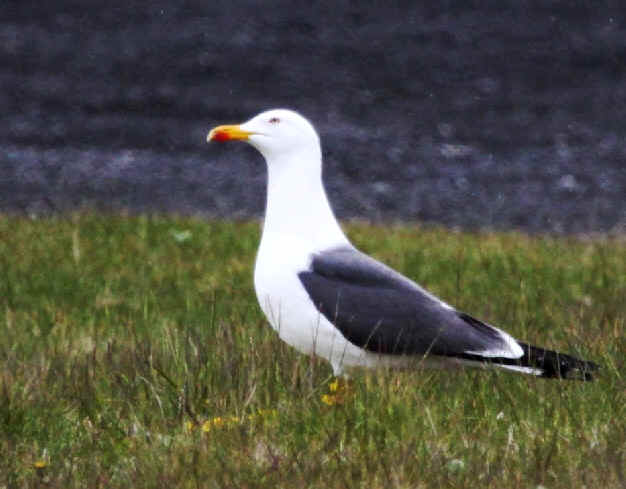
An adult Lesser Black-backed
Gull in breeding plumage
photographed during the FONT Iceland Tour in June 2015
(photo by Marie Gardner)
53. Great Black-backed Gull (ph) (*) May
Jun Sep Oct
Larus marinus
54. Black-legged Kittiwake (ph) (*) May
Jun Sep Oct
Rissa tridactyla
There is a large population of Black-legged Kittiwakes in
Iceland, where there was a steady increase during the 20th Century.
Kittiwakes, of course, are gulls. But some of their features
differ from those of other gulls. Among such features, the Black-legged Kittiwake
(1 of the world's 2 species of kittiwakes) has smaller legs than other gulls,
and it has only 3 toes rather than 4 as other gulls do.
The Black-legged Kittiwake is more oceanic than other gulls. In the
winter, outside the breeding season, it travels great distances out to
sea.
The Black-legged Kittiwake and the Northern Fulmar are two of the
most common pelagic birds of the North Atlantic Ocean. Both species often fly
about fishing vessels.
Some Black-legged Kittiwakes winter along the Icelandic coast, but most
go out to sea, with the majority departing in September.
During the summer, the Black-legged Kittiwake is one of the most numerous
seabirds around the coast of Iceland, with well over half a million pairs. As
noted above, the Icelandic population has risen in recent decades.
The main breeding sites of Icelandic Kittiwakes are on promontories or
offshore oceanic islands. The species is very gregarious, often nesting in large
crowded colonies on cliffs. About three-fourths of the Icelandic population have
been in the 12 largest colonies. At many places, they nest only with their own
kind, especially on lower cliffs, and on islands in Breidafjordur Bay.
Black-legged Kittiwakes banded in Iceland have been found in Greenland,
mostly immature birds, and in Newfoundland, and in Europe south to
Gibraltar.
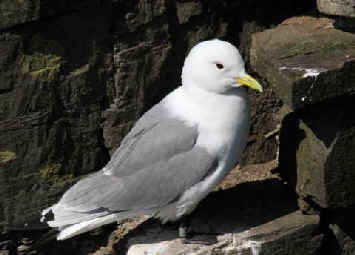
A Black-legged Kittiwake on
its cliffside nesting site,
photographed during the FONT Iceland Tour in June 2012
(photo by Gabriel Hauser)
55. Arctic Tern (ph) (*) May
Jun Sep
Sterna paradisaea
The bulk of the northwestern European population of Arctic Terns
breed in Iceland, with over 100,000 pairs, the highest population of the species
in Europe. Overall, in Iceland, there seems to have been no recent
population change.
The species nests circumpolarly, with many in the region of the Arctic Circle,
hence the bird's name. It is one of the greatest travelers on Earth. The
distance that it covers on an annual basis is greater than that of any bird.
In the autumn, the Arctic Terns that nest in Iceland, and those that do
so elsewhere in the North Atlantic, travel south along the west coasts of Europe
and Africa until they reach the Antarctic Ocean, Most that nest in northeastern
North America do the same - that is, they first cross the Atlantic to Europe
before heading south. Those that nest in Iceland start their exodus to the south
in mid-July. Most leave in August. the last go in September.
The migration pattern of the Arctic Tern is said to follow ocean currents
rich in food supplies during their long journey.
Banding has given some insight into the migration of the Arctic Tern. A
young bird that was banded in Greenland, during June, was subsequently found the
following October along the east coast of South Africa, after having migrated
over 18,000 kilometers.
Barring some misfortune, Arctic Terns can live a long life. For example,
a bird that was banded as a chick by Lake Myvatn in Iceland, was found 21 years
later in Nigeria.
A particular aspect of the Arctic Tern that's stated repeatedly, but is
always fascinating, is that they spend so much of their lives in two hemispheres
in continuous days with little or no
darkness.
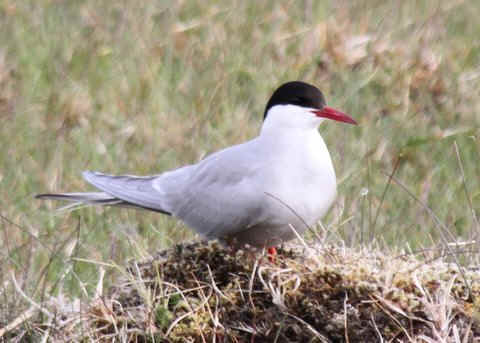
An Arctic Tern photographed during the FONT Iceland
Tour in June 2012
(photo by Gabriel Hauser)
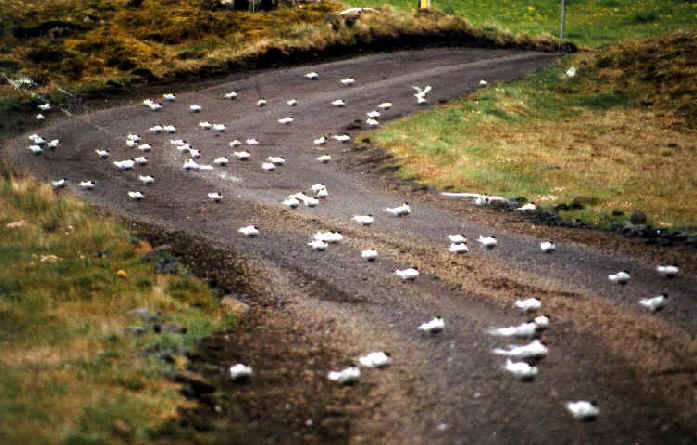
Above: A breeding colony of Arctic Terns resting on
a road, during the FONT Iceland Tour in June 2002.
Below: One of the our June 2009 Iceland tour participants on the run after
getting just a little too close
to an Arctic Tern nesting colony.
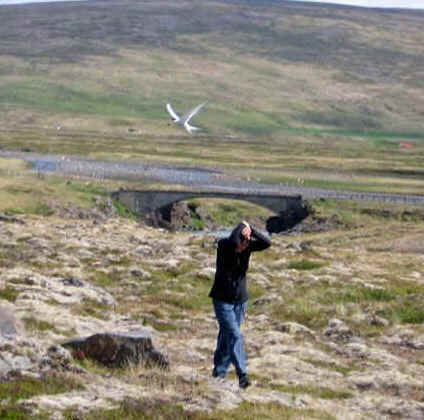
ALCIDS
56. Black Guillemot (ph) (*) May
Jun Sep Oct
Cepphus grylle
The Black Guillemot is the least common of the North Atlantic
auks. The largest numbers in the region occur in Iceland, particularly in the
border of the low arctic and boreal marine zones.
Black Guillemots never nest in large colonies, as do Puffins and other
alcids in Iceland. Often they occur in groupings of a few pairs among boulders
or along stone walls. At times, a pair will breed alone.
Black Guillemots usually lay 2 eggs, rarely 1. There is hardly a nest to
speak of, with eggs sometimes resting on bar rock or gravel, but more often very
well concealed in holes and crevices.
Black Guillemots in Iceland were, for a long time, considered residents,
but recently some that have been ringed (or banded) in Iceland have been
recovered abroad, and now indications are that about one-fourth of young
Icelandic Black Guillemots visit Greenland outside the breeding season,
that is during the winter.
It is also believed that some Black Guillemots from the High Arctic
winter in Iceland. Those birds are of the subspecies Cepphus grylle mandtii,
the "Mandt's Black Guillemot".
As nesting sites are so widely distributed all around the Icelandic coastline,
and on many islands, it is difficult to know with reasonable accuracy the exact
number of Black Guillemots that breed in Iceland. The figure has been
estimated as 20,000 pairs or less.
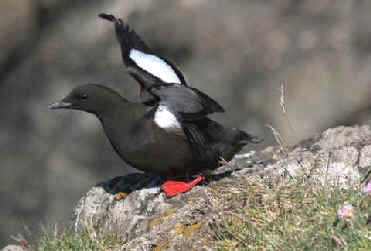
Black Guillemots photographed during FONT Iceland Tours.
Above: as the bird looks during our tours in May and June.
Below: as the bird looks during our tours in September and October.
(top photo by Gabriel Hauser, bottom photo by Alan Michnick)
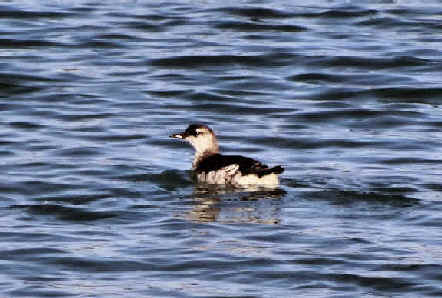
57. Common Murre (or Guillemot) (ph) (*)
May Jun Sep Oct
Uria aalge
The bulk of the Common Murre, or Guillemot, population
in the North Atlantic breed in Iceland, about 40 percent.
Both the Common Murre and the following species, the Thick-billed
Murre, nest on steep towering cliffs.
The Thick-billed Murre is more of an Arctic species, and thus it occurs
more as a breeder in northern Iceland. The Common Murre is
proportionately more numerous on the southern cliffs of Iceland.
However, about three-fourths of the Common Murres breeding in Iceland are
on the 3 largest bird-cliffs of the western fjords of northwestern Iceland:
Helavikurbjarg, Latrabjarg, and Hornbjarg, the same places where collectively
about 90 per cent of the Icelandic Thick-billed Murres
breed.
In Iceland, there are a million or more nesting pairs of Common Murres.
One of our sources indicates that there are more Thick-billed Murres in
Iceland than Common Murres. Another source says there are less.
Little is known as to where Icelandic birds of both murre species winter.
Some Common Murres, outside the breeding season, remain close to the
Icelandic coast, but most are migratory. When at sea, the Thick-billed Murre
is said to be more pelagic than the Common Murre.
In the murre colonies, Thick-billed Murres tend to nest on ledges
that are more narrow than those used by the Common Murre. The Thick-billed
Murres are sometimes in isolated pairs. Common Murres are often in
larger groups. The murre colonies are abandoned in late July.
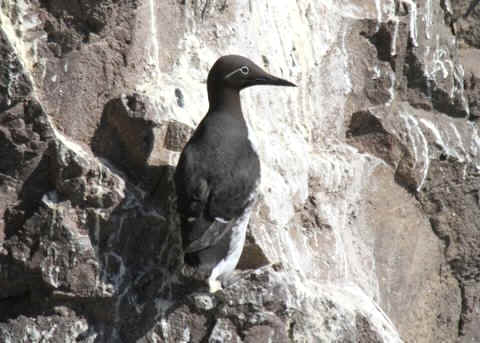
The bridled form of the Common Murre
photographed
during the FONT Iceland Tour in June 2012
(photo by Gabriel Hauser)
58. Thick-billed Murre (or Brunnich's Guillemot)
(ph) (*) Jun
Uria lomvia
The largest numbers of Thick-billed Murres, or Brunnich's
Guillemots, in the North Atlantic are in northwestern and northern Iceland
(notably, as noted above, at Helavikurbjarg, Latrabjarg, and Hornbjarg), and in parts of Spitsbergen
and Bear Island. There was a decline in the population in Iceland (at Hornbjarg,
Latrabjarg, and Grimsey) between the 1950s and the 1980s.
59. Razorbill (ph) (*) Jun Oct
Alca torda
Razorbills are very sociable birds, often standing upright or lying
on their bellies on cliff-ledges among murres and puffins.
The Razorbill population in Iceland has been estimated at 380,000
breeding pairs. The largest known Razorbill colony in the world is in
northwestern Iceland, at Storurd at Latrabjarg. About 60 percent of the
Icelandic population breed there.
The bulk of the population of the Razorbill in the North Atlantic
breed in Iceland, about 70 percent. About 20 per cent breed in the British
Isles.
Razorbills nesting in Iceland are believed to be largely migratory.
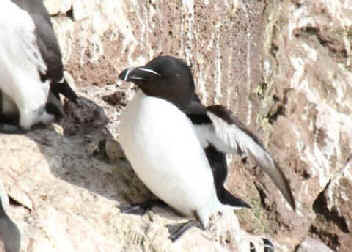
A Razorbill at a nesting colony of a large seaside
cliff
during the FONT Iceland Tour in June 2012
(photo by Gabriel Hauser)
60. Atlantic Puffin (ph) (*) May Jun
Sep Oct
Fratercula arctica
The bulk of the Atlantic Puffin population, up to 10 million
pairs, nest in Iceland, with most concentrated in the Westmann Islands and
nearby along the south Icelandic coast, and in the area of the Breidhafjordhur
Bay in western Iceland.
Other substantial, but considerably smaller, populations breed in Europe in the
Faroe Islands and Scotland, with each having over half a million pairs. In North
America, the Atlantic Puffin breeds in eastern Canada, notably
Newfoundland, and south, in small numbers to Maine in the US.
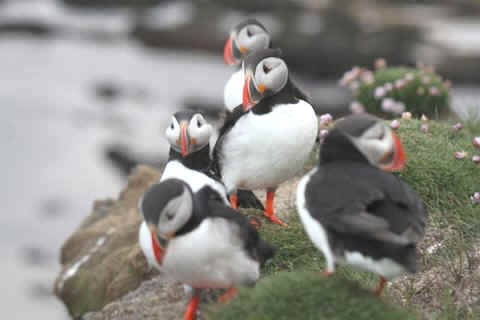
Atlantic Puffins during the FONT Iceland Tour in
June 2012
(photo by Gabriel Hauser)
A decline of the Atlantic Puffin population occurred during the 20th Century in Iceland and
elsewhere in the range of the species. Such a decline has been due in part to
human persecution along with other factors such as pollution and changes in the
food supply, resulting it has been said in part from oceanographic changes.
The breeding sites of the Atlantic Puffin are on offshore islands,
oceanic cliffs, and steep mountainsides near the sea. Some large puffin colonies
are widespread on low grassy islands, but the largest colonies are on high
sea-cliffs of uninhabited islands. Atlantic Puffins nest in burrows
usually dug by the birds themselves, using their beaks to dig and their webbed
feet to kick out the dirt. Their burrows, up to 2 feet in length, are in the grass-covered
ledges of the cliff-faces or in the slopes of the cliff-tops. In the burrows,
from each pair of Atlantic Puffins, there is only one egg.
In Iceland, the same individual Puffin has been found nesting in the same
hole for 30 years, meaning that the bird was at least 35 years of age, as Puffins
begin to breed when they become 5 years old.
Atlantic Puffins usually keep the same mate for life. However, if no
offspring are produced for several years, they will "divorce" and find
a new mate, possibly an older bird whose previous partner had
died.
Puffins "talk" in their underground burrows The sound that
comes from their soft earthen rooms is a soft growling-moaning. If a person were
to sit quietly on the grass in a puffin colony, he or she can hear the
birds "talking" underground in their nests.
It is fascinating how many fish an Atlantic Puffin can hold in its bill.
And also impressive is how it can add to its collection without losing one. The
answer as to why the Puffin can do these things so well lies in the small
spines on their tongues and the roofs of their mouths, thus enabling them to
spear and hold the little fish as they do.
A
characteristic of the Atlantic Puffin is that it likes to strut about for
a while with its bill filled with fish before returning to its burrow and
feeding its young.
The Atlantic Puffins that nest in Iceland are migratory. They start to
arrive in April. Their main breeding season begins around the 20th of May.
During the first half of August, parents gradually stop feeding the young. Thus,
at that time, the parents abandon the burrows. In late August, the exodus of
young Puffins increases. By mid-September, all of the Atlantic Puffins of
Iceland have left their breeding grounds and gone to sea.
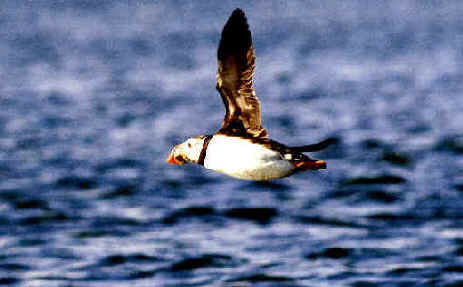
An Atlantic Puffin in flight photographed during a
FONT Iceland Tour
THE FOLLOWING ARMAS HILL WROTE, AS PART OF A NARRATIVE, AFTER THE JUNE 2011 FONT TOUR
IN ICELAND, RELATING MOSTLY TO THE DECLINE OF THE ATLANTIC
PUFFIN:
Most of the many Atlantic Puffins in Iceland
are not along the northern coast of the country, but rather, they are locally
abundant along
the southern.
In the southernmost town on mainland Iceland, late in the evening, above the
Hotel Lundi in the heart of the town, I noticed a Puffin flying out from the
cliff. "Lundi" is the Icelandic word for "Puffin".
I watched the small bird fly with its little wings pitter-pattering rapidly. It
headed toward a distant swarm of birds that were all flying about in the twilit
sky by another cliff just above the ocean. I went closer.
That swarm, that at a distance appeared superficially as an evening mass of
insects or bats was of course, as I just noted, and knew at the time, of birds.
And all of them were Puffins with their little wings fluttering rapidly. There were at least a thousand in the sky. And many more than that were
out on the water. Others were standing out by their burrows on the cliff-tops.
It was going on midnight, but as it was mid-June, the lightness enabled me to
enjoy the spectacle.
The place in Iceland with the most Puffins was not far away: an offshore
group of 14 islands known as Vestmannaeyjar,
or the Westmann Islands.
We went there the next morning on the first ferry. What was more than a 3-hour
(and sometimes rough) ferry-ride to the islands is now less than half an hour,
from a new port.
From the ferry on the way to Heimaey, the
only one of the Westmann Islands that is inhabited by people, about 4,000 of
them, a flock of Manx Shearwaters was seen. In Iceland, that species only
nests in Vestmannaeyjar.
Also seen from the ferry were Northern Gannets, Northern Fulmars, Black-legged
Kittiwakes, and yes, Puffins.
Whereas there are people on only 1 of the 14 islands, there are birds inhabiting
all of them, on sheer rocky cliffs and otherwise. When we took a boat-ride
throughout the islands, we saw many.
There were 5 species of alcids. In addition to the Atlantic Puffin,
there were Razorbills, two kinds of Murres (mostly Common,
also some Thick-billed), and the Black Guillemot. We saw all of
these on and by those shear rocky cliffs along with the many Kittiwakes and
Gulls and Gannets.
On Heimaey Island, where we spent most of a
day, and a night, there's a place above a high seacliff that's said to be a
place for Puffins. At that spot, there is a wooden hide, or blind, with
openable windows, at a "Puffin spot". When we first went there,
during the day, there were Puffins in the area, but they were ALL below,
well below us, on the water of the sea. There were none on the nearby grassy
slopes above the cliffs.
When we returned later in the day, it was much the same.
But I remembered the previous evening's activity back by the mainland coastal
cliffs, so I returned to the hide at about 10pm. And, then, at that time, the
Puffins were coming in too!
So, I went back to the hotel to get the others, and soon, when we were inside
the hide, there were Puffins outside, sometimes nearly within
reach! There were well more than a thousand, for about 2 hours, before
they started to go, individually or in small groups, back down to the ocean
below.
What we learned, sadly, when we were in Iceland, and particularly when we were
in the Westmanns, is that the Atlantic Puffin has not been doing well,
for a few years now. It is becoming, and I must say sadly again, a species in
peril.
Yes, the same bird that in Iceland is depicted so many places, as on postcards
everywhere, on shirts and other garments, and on signs and in ads, is now in
trouble. The bird, clown-like in appearance, called the Puffin, or Lundi,
has been as common in Iceland as a caricature can be.
Referring to the "real thing", Iceland has had the largest number of Atlantic
Puffins anywhere, with over half of the total global population of the
species residing there in the summer.
An estimated 3 million pairs of Atlantic Puffins have been breeding in
Iceland each year - that is about 6 million birds. On average, 70 per cent of
the total Icelandic population of Atlantic Puffins are breeders, so the
total number in Iceland each summer has been from 8 to 10 million
birds.
And about half of the Atlantic Puffins in Iceland have been in the Westmann
Islands. As noted earlier, it has been the place in Iceland with the
most - but not just the most in Iceland.
The Westmann Islands has been the place with the most Atlantic Puffins on
Earth, with some 700,000 nesting pairs - that is 1,400,000 birds, with each pair
normally raising but one young bird per year.
So, it has been, on average, that about 20 per cent of the global population of Atlantic
Puffins (1 out of 5) has nested on the Westmann Islands.
And the birds even had a new island there on which to nest. It was noted that
there are 14 islands in the Westmann group. There were 13. That was until 1963
when a new island was created, as a volcano erupted in the ocean. On that
island, called Surtsey, afterwards,
Atlantic Puffins began making their
homes.
But during more recent years, the Atlantic Puffin population has fallen
so drastically that the species is being put on the Birdlife International
"watch list".
Overall, during the last decade, there has been a 20 per cent drop in the
species' population. And during the most recent years, the situation has
worsened yet.
In 2007, Maria Frostic, an employee of NASA in the US, took a leave in July and
August, and went to the Westmann Islands,
intending to make a documentary film about medieval sagas. Instead, learning
immediately upon her arrival how poorly the Puffins were doing during
that nesting season, she did instead a film entitled "Plight of the
Puffins" that aired the following year on television on PBS.
In 2009, it was in the news that on the Westmann Islands "very few Puffin
chicks hatched and survived the summer".
When we were in the Westmanns in June 2011, we were told that in the summer of 2010,
the Puffins on
the islands again did not successfully raise their young. And we were also told that the
current 2011 season did not yet seem to be any better.
A reason said for this, and also purported in that 2007 documentary
film, is the depletion of the Puffin's food-source, a fish called the Sand-eel.
From whatever cause, and maybe it's been said due to climatic change, that fish
is now scarce where it used to be abundant. And where it is now scarce is where
the Puffins are during their nesting season.

An Atlantic Puffin with Sand-eels
On the Westmann Islands during August, for years, there has been a
tradition. Puffins are weak flyers, even at best. They do best when they
take off into the air from the top of a cliff. Sometimes, young Puffins, after leaving their burrows, descend not to the water as they should, but
instead into the town on Heimaey.
They land on a moist road or street as it appears to be water. In the
evenings, when that happens, the children in the town go about and gather up the
forlorn Puffins, putting them in boxes to release them from cliff-tops in
the morning. The child, who doing so, saves the most becomes the "Puffin
Fledgling King" for a year. We were told that in 2010 there were no
young Puffins for the children to rescue.
After my return home from Iceland, I looked a bit more into the situation
regarding the Atlantic Puffins in Iceland. I found it written that the
decline of the species has been due in part to factors such as "human
persecution", pollution, and the reason that I had already been told,
"a shortage in the food supply resulting from oceanographic changes".
Due to the last of these, it's written that there has been ""poor
breeding success" and "a high mortality rate of young
birds".
I found it said that the fish consumed by Atlantic Puffins include, as
noted already, Sand-eel, Ammodytes sp., which is the majority of the diet
of the chicks, and some forage species including juvenile pelagic fishes such as
Herring, Clupea hareegus, and juvenile and adult Capelin, Maliotus
villosus.
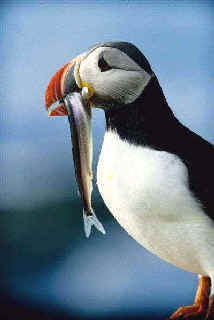
An Atlantic Puffin with Capelin
I also found in a non-nature publication that in 2010, at least 38
Icelandic fishing vessels each caught fish worth more than 1 billion Icelandic
Kroner (or 8.6 million US dollars), which was a new record. As a comparison, 28
vessels reached that goal the previous year, in 2009.
Relating to the Capelin, the small cold-water fish eaten by Puffins:
After some years with meager catches, it was said that 390,000 tons would be
fished in 2011, providing a needed boost to the economy and a good increase in
exports. A starting quota of 200,000 tons was issued when the size of the stock
was first estimated. A further quota of 125,000 tons was later added. The quota
was
decided on the basis of leaving 400,000 tons of spawning Capelin in the
waters to ensure sustainable stock.
A bit about Capelin biology: They come to the sandy shores of southern
Iceland to spawn between the ages of two and six. After spawning, most
die.
During the 3 years, 2008-2010, Capelin were scarce in Icelandic waters, with
about 100,000 tons caught each year.
Hopefully, an increase in one of the prey of the Puffin will help the bird.
And if that were to happen with the Sand-eel, the Puffin
would have better times ahead. Optimism certainly is not in order yet. Only time will tell.
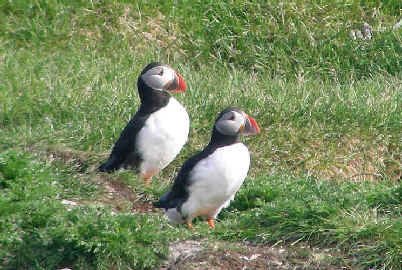
Atlantic Puffins photographed by their burrows
during the FONT Iceland Tour in June 2009
(photo by Gerin Hood)
PIGEON
61. Common Pigeon
(or
Feral Pigeon) (*) May
Jun Sep Oct
Columba livia
OWL
62. Short-eared Owl (ph) (*) Jun
Asio flammeus
The Short-eared Owl is the only owl known to breed in Iceland
on a regular basis, with maybe 100 to 200 pairs doing so annually.
One of our sources says that the main breeding area of the species in Iceland is
in the southern part of the island, but that it does nest dispersively elsewhere
as well. Another source says that the bird is a sparse breeder in all of
Iceland, but most common in the north. At any rate, throughout the country there
are not many nests.
The Short-eared Owl was first known to nest in Iceland in 1912. Prior to
that it has been considered a vagrant in the country.
Nests are in boggy areas, often on drier ground near lakes or fens, usually well
hidden in birch thickets or heather. As the young owlets grow, the female parent
remains at the nest feeding them, as the male hunts for prey. The parents
continue to feed the young birds in the brush until they can fend for
themselves.
Icelandic Short-eared Owls are mainly migratory, wintering in western
Europe. Those in Iceland in the winter are found in "woodlands" and
parks where Wood Mice may be hunted.
The main staple of Short-eared Owls in Iceland are probably small and
young birds.
PASSERINES
63. Northern Raven (ph) (*) May
Jun Sep Oct
Corvus corvax varius (subspecies
on Iceland and the Faeroe Islands)
The Northern Raven is the largest of the world's passerine
birds. It is a bird well known to most people in Iceland, not only in the
countryside, but also in folklore.
In many northern cultures, including the Icelandic, the Northern Raven
has had a special place in mythology. Few birds have figured in as many
folktales as the Raven in northerly lands as far apart as Iceland and
Alaska, and through the ages in societies from the Vikings of Europe to the
Native Americans of the tundra. Certain attributes of the bird are said to cause
this - including their behavior and intelligence.
Here's an example of an Icelandic folktale relating to the Raven:
A man, who was riding on his way home from Budir to Stadarstadur on the
Sbaefellsnes Peninsula in western Iceland, found a lumpsucker fish, which
he put into his bag.
When he passed the fishing-station, there were 2 Ravens sitting on one of
the huts, and one of them seemed to ask him for a bite to eat. The man replied
that he had nothing, as he had forgotten about the fish he had found.
The Raven reminded him that he had something in his bag. The man duly
found the fish, and gave a piece of it to the Ravens.
He then asked the birds if the men from his farm would have a good catch that
day, and the Ravens replied that they would catch 2 very large
halibuts.
The man rode on home and told his family the whole story, and they only laughed
at him for his stupidity.
The man remained undaunted and left for the fishing-station in the evening with
2 pack horse to fetch the catch - and learned that his men had indeed caught
2 very large halibuts that day!
Thus the existence of the folk tradition which says that God rewards
those who are kind to the Raven.
There are from 2,000 to 3,000 breeding pairs of Northern Ravens in
Iceland.
The Northern Raven is the only corvid that commonly occurs in Iceland,
where it resides year-round.
The Northern Raven may sometimes seem to be heavy, or even clumsy in the
air, but in fact it is a very agile flyer, especially when it is in a "good
mood", when it will sometimes give an extraordinary display of aerobatics,
twisting and rolling in seemingly all directions.
The caw of the Northern Raven is said not to be very attractive. But the
voice of the bird is actually quite variable, and the Raven can even,
rather like a parrot, give a fairly good imitation of human
speech.
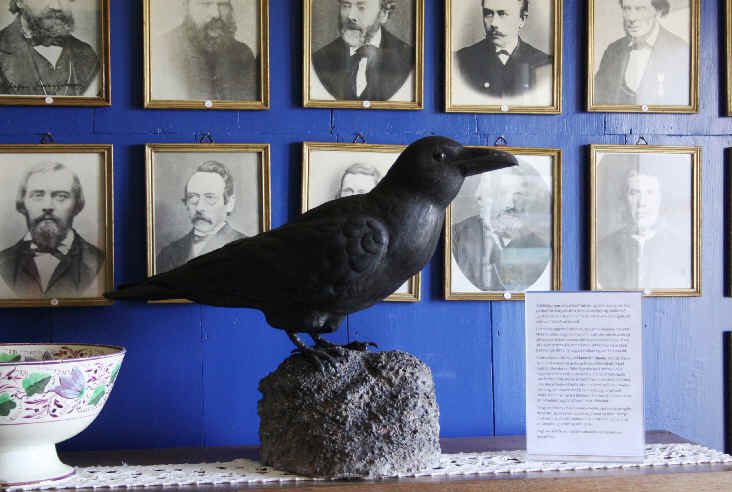
This was the only Raven during
our June 2015 Iceland Tour
that stayed still to have its picture taken.
It's a wooden carving inside a historic house.
Ravens are known for being "smart"
and in that regard, all of our Ravens outside
quickly flew to be just a little too far away.
(photo by Marie Gardner, who wanted to photograph a Raven
any way she could)
64. "Icelandic" Eurasian Wren (*)
Jun Sep Oct
Troglodytes troglodytes icelandicus
The "Icelandic" Eurasian Wren was, for a long time,
said to be the smallest of Icelandic birds, but now the Goldcrest, which
is smaller, occurs in the
country as a rare breeder.
The subspecies of the Eurasian Wren in Iceland is unique to the island. It is
slightly larger, darker, and more streaked than subspecies that occur in other
places.
Due to its size, color, and quick behavior, the Wren in Icelandic folk tradition
has been referred to as "the mouse's
brother".
65. Northern Wheatear (ph) (*) May
Jun Sep Oct
Oenanthe oenanthe
During the summer, the Northern Wheatear is distributed over
a range in Europe stretching from the Mediterranean to Greenland. It is rather
astonishing how this small bird, originally a southern species, has adapted to
natural conditions in the far north.
The Northern Wheatear feeds on insects, and they need a good supply of
them when nesting and raising young.
In the autumn, the Northern Wheatears from Greenland and Iceland have a
long flight south to their wintering areas in Africa. Northern Wheatears
that breed in Greenland are spring and autumn visitors in Iceland. Most Wheatears
depart Iceland in late September. Sometimes, the species is seen there in
October.
Northern Wheatears that nest in Iceland, Greenland, northeastern Canada,
and the Faroe Islands are classified as the subspecies Oenanthe oenanthe
leucorrha. Due to their long annual flights, these birds have developed
longer wings than the Wheatears in mainland
Europe.

An adult male Northern
Wheatear
photographed during the FONT Iceland Tour in June 2015
(photo by Marie Gardner)
66. Redwing (ph) (*) May Jun
Sep Oct
Turdus iliacus
The Redwing is a common breeding bird throughout Iceland.
Most Icelanders know the bird by both its appearance and its song. It sings both
during the day and at night.
Most of the Redwings that breed in Iceland are migratory, when their main
wintering grounds being in Scotland, Ireland, western France, and south into the
Pyrenees.
They return from there to the coast of southern Iceland in early April,
continuing into the central and northern parts of the country a few weeks later.
In September and October most Redwings leave Iceland, often stopping
first, for a while, in gardens to feed on the red rowanberries, that they find
delicious, in preparation for their upcoming flight over the ocean. Some of
those Redwings, however, seem unable to pull themselves away from the
rowanberries, and thus spend the winter in Iceland.
The Redwing is one of the few nesting birds in Iceland to have two broods
in the summer - and sometimes three.
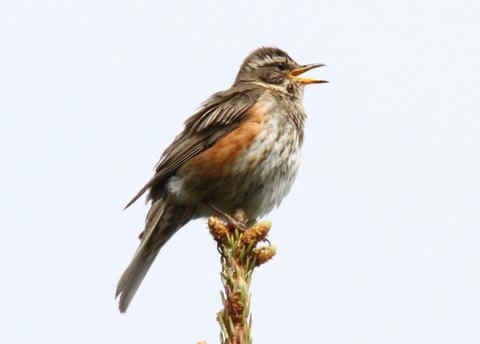
A Redwing photographed during
the FONT Iceland Tour in June 2012
(photo by Gabriel Hauser)
67. Common Starling (ph) (*) May Jun
Sep Oct
Sturnus vulgaris
The Common Starling is a recent settler in Iceland. It first
bred in Hofn in Hornafjordur in southeast Iceland in 1941, and it has bred there
since.
Breeding began in Reykjavik in 1960, and it is now estimated that about 3,000
pairs are resident in the city and its suburbs. The species has now spread
elsewhere in the country. During the FONT June 2011 Iceland tour, Starlings
were seen along the northern Icelandic coast in Blonduos.
68. House Sparrow (*) May
Passer domesticus
69. Common Redpoll (ph) (*) May
Jun Sep Oct
Carduelis flammea
Depending upon the year and the season, the population of Common
Redpolls in Iceland can fluctuate from 2,000 to 20,000 pairs. Factors
causing this variation can be climatic conditions and the abundance of birch
seeds.
In Iceland, the resident Common Redpolls, that is the "Icelandic
Redpolls" of the subspecies Carduelis flammea islandica, have
spread with "forestation". In addition to birch trees, the birds also
have a preference for spruce trees for nesting, and rowanberry seeds as food. "Icelandic
Redpolls" can be found nesting in gardens in towns and villages.
Common Redpolls also eat insects in the summer.
Throughout the year, Redpolls fly about in small flocks in Iceland.
Common Redpolls from Greenland, of the subspecies
Carduelis flammea
rostrata, pass through Iceland in the spring and autumn, and some of them
stay on the island through the winter.
The Greenland birds are of the same subspecies as those that breed in northeast
Canada. A portion of the birds that breed in Greenland winter in northwest
Europe.
70. Meadow Pipit (ph) (*)
May Jun Sep Oct
Anthus protensis
The Meadow Pipit is the most common passerine bird in Iceland
in the summer, with up to a million breeding pairs.
Icelandic birds are migratory, wintering from western France south to Morocco.
Most leave Iceland in September. A few linger into October. Returning birds in
the spring arrive in late April and early May.
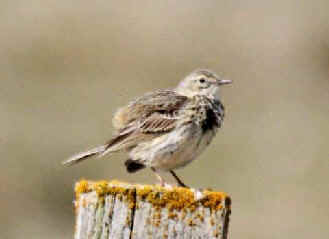
A Meadow Pipit photographed
during the FONT Iceland tour in June 2012
(photo by Gabriel Hauser)
71. White Wagtail (ph) (*) May Jun
Sep Oct
Moticilla alba
The White Wagtail, probably more than any other bird in
Iceland, occurs in places of human habitation. Most farms have one or two pairs
as summer residents. The species is common in towns and villages throughout the
country.
The White Wagtails of Iceland are migratory, leaving the country between
late August and mid-September, for winter quarters mainly along the west coast
of Africa.
Unusual, but the subspecies of the White Wagtail, Moticilla
alba yarrellii, has occurred in Iceland.
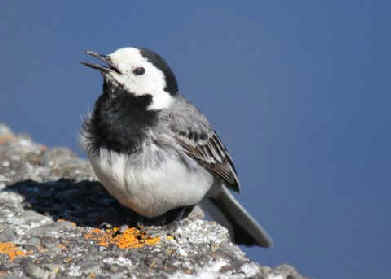
A White Wagtail photographed
during the FONT Iceland Tour in June 2012
(photo by Gabriel Hauser)
72. Snow Bunting (ph) (*) May Jun
Sep Oct
Calcarius (formerly
Plectrophenax) nivalis
The Snow Bunting is a bird if the Arctic, breeding in all the
northernmost countries in the world. No passerine bird has been found nesting
closer to the North Pole than the Snow Bunting.
In Iceland, there are some 50,000 or more breeding pairs of Snow Buntings.
They are most common in the highlands. In the summer especially, the species is
less common in the lowlands.
Late in the summer, Snow Buntings in the Icelandic highlands gather into
flocks, and then move into the lowlands, as the bird's feeding habits change
with the seasons. During the summer in the high country, Snow Buntings
eat insects.
In the winter, Snow Buntings frequent the seashore, often near human
habitation. It is a hardy bird that can tolerate cold weather, provided it has
sufficient food.
Icelandic Snow Buntings have generally been considered residents, but
some do migrate to more southerly countries. Birds from Iceland have been known
to winter in Scotland.
Birds from Greenland, and other northerly places, are either winter visitors in
Iceland, or migrants that stop-over on the island as they pass through in the
spring and autumn.
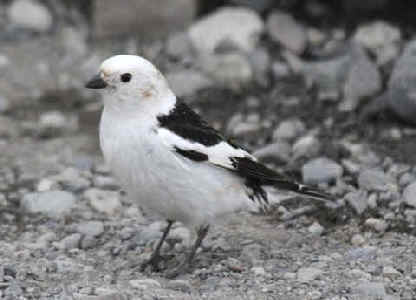
A male Snow Bunting in
breeding plumage
photographed during the FONT Iceland Tour in June 2012
(photo by Gabriel Hauser)
Formerly an Icelandic Breeding Bird, now seemingly extinct as such in Iceland:
73. Water Rail
Rallus aquaticus
The Water Rail was a sparse breeder in Iceland in the expanses
of Lyngbye's Sedge and other lowland marshes, mainly in the southern part of the
country.
But following the effects of the draining of wetlands and predation by
the introduced American Mink, the Water Rail is mostly likely extinct as
an Icelandic breeder. No nest is known to have been found there since 1963.
A very few Water Rails are spotted in Iceland on occasion, generally in
the fall and winter. They are most apt to be found in ditches, at
springs, and in geothermal areas. They are thought to be vagrants from Europe.
The bird is very shy, and is rarely seen in flight - although vagrants from
mainland Europe would have to fly well to get to Iceland.
Water Rails were found in southern Iceland at Hveragerdi in January
2011, and in southeast Iceland on October 27, 2011.
Formerly an Icelandic Breeding Bird, now globally extinct:
74. Great Auk
Pinguinis impennis
The Great Auk was a large flightless seabird that became extinct in
1844.
Although they were flightless, Great Auks, as good swimmers, were
strongly migratory, with some, probably from Newfoundland, occurring in the
winter as far south along the Atlantic coast of North America as the Carolinas.
It can not be questioned that Great Auks bred on small islands, skerries,
and rocks off the coast of Iceland.
Bones
of 8 individuals, indicating breeding, were found at
Kyrkjuvogy and Baejsker.
According to tradition, there were 4 small Icelandic islands where Great Auks
either formerly bred, or habitually roosted.
All were called "Geirfuglasker"
(or Gare Fowl Skerries - "Gare Fowl" was the Icelandic name for
the Great Auk).
For two of those islands, the record was only by word of
mouth and quite vague.
The two well-documented Icelandic offshore locations as breeding places for the
Great Auk were:
1) Rocks in a cluster about 20 miles of the Reykianes Peninsula in southwest
Iceland, among them Eldey Rock and Geirfuglasker.
This was the principal
location for the Great Auk in Iceland.
Geirfuglasker, where most of the Great
Auks bred, disappeared under the sea in 1830 during a volcanic cataclysm
resulting from an earthquake. Birds moved to Eldey Rock when their ancestral
home sank. It was there, on Eldey, where the last of the world's Great Auks
were killed, a pair o June 3, 1844. Eldey, unfortunately, was more accessible to
men than Geirfuglasku had been.
2) the Westmann Islands (Vestmannaeyjar), off south-central Iceland. Even though
the Great Auk was documented as occurring there, any evidence of their
breeding came through local tradition.
It is believed that a pair of Great Auks only laid one egg a year. Thus
they reproduced rather slowly.
As men appeared in the areas where they bred, the population of the Great Auk
rapidly dwindled.
In North America, the species became extinct between 1800
and 1825. It became extinct in the Faroe Islands by about 1800, in the Orkney
Islands by 1811, in Greenland by 1815, and on the island of St. Kilda
by 1821.
As the Icelandic population of the Great Auk shrank, birds were killed
and skins sold to collectors and natural science museums, 27 Great Auks were
killed in the area of Geirfuglasker in 1830-31. 10 were killed on nearby
skerries from then until 1841,
During the 20th Century, in 1955, the Icelandic Museum of Natural history in
Reykjavik, obtained a Great Auk skeleton - one of only 10 such skeletons
in existence. The bones were collected in 1908 on Funk Island, where there once
had been a large Great Auk colony.
Also at the Icelandic Museum of Natural History, there is a stuffed Great Auk.
It was bought at an auction in London in 1971. It had been a skin that was in a
collection in Denmark, obtained during a trip to Iceland in 1821.
The Great Auk was closely related to another alcid that is not flightless
and is still with us today, the Razorbill.
With the scientific name "Pinguins" lasting forever, the Great
Auk was a northern counterpart of the "penguin" of the
Southern Hemisphere.
The Great Auk was not as much of an Arctic bird as
some penguins are of the Antarctic. But the evolutionary histories of the
Great Auk and the penguins appear to be rather similar.
Had the Great Auk
continued to survive, it would have been interesting to compare the behavior of
the species.

A sculpture of a Great Auk with tour participant
Alan Mitchnick
during the FONT Iceland Tour in September 2013,
From where this statue is we could see the island offshore
where the last Great Auks lived in 1844.
The Great Auk in life was, of course, not a big as this statue.
The flightless birds were 27.5 inches from head to foot.
(photo by Armas Hill)
2)
COMMON MIGRANTS IN ICELAND (Non-breeders unless
noted otherwise)
North in the spring, south in the late-summer
or early-fall:
75. Greater White-fronted Goose (*)
Oct
Anser albifrons
The Greater White-fronted Goose is one of the three species of
geese that stop in Iceland during their migrations in the spring and autumn.
The Greenland race of the White-fronted Goose travels between
Greenland, where it breeds, and Scotland, where it winters. That population has
been small, but increasing in recent years. It is now about 30,000 birds.
The call of the White-fronted Goose is higher pitched, and more musical
than those of the other geese in Iceland.
The other two species that stop in Iceland during their migrations are noted
below, the Barnacle Goose and the Brant Goose.
Unusual, but the "Eastern, or Siberian White-fronted Goose", Anser
albifrons albifrons, has occurred in Iceland. One was in southeast
Iceland at Hofn on April 6 & 12, 2015.
76. Barnacle Goose (ph) (*) Jun
Sep
Oct (rare in Iceland in June)
Branta leucopsis
The Barnacle Goose is certainly one of the most beautiful of
the world's geese, with its striking and contrasting color pattern.
Barnacle Geese travel across Iceland twice each year, going north in the
spring and south in the fall. The pass mostly over the central highlands, often
following the largest river, They usually stop in the spring at Hunafloi and
Skagafjordur in northwest Iceland. In the autumn, they often sojourn in southern
areas of the central highlands.
The Barnacle Goose is an Arctic breeder, doing so in crowded colonies on
steep cliffs in northeastern Greenland.
Outside Greenland, Barnacle Geese breed on Svalbard and Noraya Zemiya,
also there on cliffs.
Until recently, it was believed that a Barnacle Goose seen in Iceland
during the mid-summer would be an immature bird that had failed to continue
further north on its spring-time journey from the British Isles, where Barnacle
Geese that pass through Iceland winter. But it now has become known that a
few, actually a very few, Barnacle Geese breed on occasion on skerries
(small islands) in Briedafjordur, in western Iceland.
In 1984, on one such skerry, there were 3 Barnacle Geese nests,
with total of 5 eggs. Nowadays, from 5 to 10 breeding pairs of Barnacle
Geese occur annually in Iceland.
And Barnacle Geese have also been found to nest elsewhere in Iceland - in
a river canyon and by a glacial river in Skaftafellssysla.
The 35,000 or so Barnacle Geese traveling south from Greenland arrive in
Iceland in the middle of September. They continue their journey south from
Iceland in October.
The Barnacle Goose has a sharp call like a dog's
bark.
77. Brant Goose (ph) (*) Sep Oct
Branta bernicla hrota
Unusual, but the "Black Brant", Branta
bernicla nigricans, has occurred in Iceland.
WADERS (or SHOREBIRDS)
78. Sanderling (ph) (*) May Jun
Sep
Calidris alba
The Sanderling is one of 3 species of shorebirds that are
regular passage migrants in Iceland. The other 2 species are the Red Knot
and the Ruddy Turnstone. All 3 species breed in Greenland and on the
northern Arctic islands of Canada, visiting Iceland in the spring and autumn
when migrating from and to their wintering quarters in western Europe.
Fewer Sanderlings visit Iceland than Ruddy Turnstones.
79. Red Knot (ph) (*) Jun
Calidris canutus
Around 200,000 Red Knots visit Iceland every year, arriving
from the British Isles in large flocks April and the first part of May. They
remain in Iceland for about 3 weeks, mostly along the western and southwestern
coasts, feeding on various mollusks, sand hoppers, and flies.
80. Ruddy Turnstone (ph) (*)
May Jun Sep Oct
Arenaria interpres
As noted above (in the above comments under "Sanderling"),
the Ruddy Turnstone is 1 of the 3 species of shorebirds that are regular
passage migrants in Iceland. The third, as noted is the Red Knot. A few
of each occasionally winter in Iceland, especially the Ruddy Turnstone.
As noted above, the Ruddy Turnstone, or simply the Turnstone as it
is called in Europe, breeds in Greenland and elsewhere in the High Arctic. Also,
there are some populations of the Turnstone in Europe that breed south of
the Arctic Circle, on the isles, skerries, and beaches of Scandinavia, but the
species doe not nest in Iceland.
From the fall thru spring:
GULL
81. Iceland Gull (ph) (*)
May Jun Sep Oct
Larus glaucoides
Iceland Gulls
do not nest in Iceland. It is a winter visitor to the island, coming from
breeding grounds in Greenland, Baffin Island, and other nearby islands.
The species is occasionally observed in Iceland in the summer.
ALCID
82. Dovekie
(or
Little Auk) (*) Oct
Alle alle
The Dovekie is one of the smallest of seabirds, hence its other name,
used more often in Europe, the Little Auk.
The Dovekie is an Arctic and an oceanic bird that is a common breeder
north of Iceland, in the area between Greenland and Novaya Zemlya. Huge colonies
exist in that area on Greenland, Jan Mayen, and Svalbard, and as far east as
Franz Joseph Land.
In Iceland, the Dovekie formerly bred at various places in the northern
part of the island. Iceland has been at the southern limit of the species'
breeding range. Around 1900, several hundred pairs nested in far-northern
Iceland, particularly on offshore islands: Grimsey, Langanes, and perhaps
Kolbeinsey.
That Icelandic Dovekie nesting population declined greatly during the
20th Century, probably due to a warming climate. Recently, on Grimsey Island
only a few nested until in 1983, just 2 breeding pairs were present there. Since
then, the species may have disappeared from that island, and now it may no
longer be an Icelandic breeding bird.
Where Dovekies do nest, they make virtually no nest - laying 1 egg on
bare earth, usually in holes and crevices between boulders. At Dovekie
breeding sites, the continuous twittering of the young can be heard from
within the rocks.
Overall in their range, Dovekies winter in large numbers at the edge of
polar drift ice. The species is observed fairly frequently in Iceland in the
winter, especially following northerly winds, and often it is seen when drift
ice approaches the island. Some may be swept inland by storms.
When Dovekies are seen in flight, it can be seen that as the wings are so
small the bird flies with wing-beats that are very rapid
Dovekies, when they are at sea, feed on plankton and various kinds of
pelagic crustaceans.
THRUSHES (TURDUS)
83. Fieldfare
Turdus pilaris
A thrush mostly in mainland Europe, the Fieldfare can be a relatively common
autumn and winter visitor in Iceland. It has on occasion stayed in Iceland into
the summer and has bred several times in the country since 1950, both in the
north and the south.
A Fieldfare was at a garden in southern Iceland, in Selfoss, the week of
April 12-18, 2015, along with 5 Common Blackbirds, 4 Common
Chaffinches, and 1 European Robin.
84. Common Blackbird (*) Jun Sep
Turdus merula
The first confirmed breeding in Iceland of the Common Blackbird was in Reykjavik
in 1969. The species has bred regularly in Reykjavik since 1991. It has also
bred elsewhere in southern Iceland.
As noted, with the previous species, 5 Common Blackbirds were at a garden
in Selfoss, in southern Iceland, the week of April 12-18, 2015.
Usually from spring into
summer, sometimes later:
SHEARWATERS
85. Great Shearwater (ph)
Puffinus gravis
Both the Great Shearwater, and following species, the Sooty
Shearwater, breed in the Southern Hemisphere. They migrate to the North
Atlantic Ocean, and Icelandic waters, during the Southern Winter. Both species
are regular visitors off the Iceland coast, more often seen south of the island,
from May to October. As noted in the figures here, the Sooty Shearwater
is by far the more common of the two species in Icelandic
waters.
86. Sooty Shearwater (ph)
Puffinus griseus
100 Sooty Shearwaters were seen at sea off southeast Iceland on
October 6, 2011. 15 were on October
27, 2011.
SWALLOW & MARTIN
87. Barn Swallow (ph) (*) Jun
Hirundo rustica
88. Northern House Martin (*) Jun
Delichon urbicum
3) UNCOMMON TO RARE VISITORS TO ICELAND
(Non-breeders unless noted otherwise)
These species are generally found in Iceland
annually.
GEESE and DUCKS
89. Canada Goose
Branta canadensis
One Canada Goose was in southern Iceland at Sydri Syrlaekur/Floi
on April 19, 2015.
90. Snow Goose (ph) (*) Sep
Chen (was Anser)
caerulescens
91. American Wigeon (ph) (*) Oct
Anas americana
92. Common Pochard (ph)
Aythya ferina
The Common Pochard is observed annually in the summer at Lake Myvatn
in northern Iceland, where the species first bred in 1954. It has been known to
breed there several times since. Otherwise, the Common Pochard is seen
mainly as a visitor in southern Iceland.
In northeast Iceland, a Common Pochard was at Skjalftavatn on April 19,
2015, and one was in southwest Iceland, at Sandgerdi, on May 15, 2015.
93. Common Goldeneye (ph) (*) Jun
Bucephala clangula
In Iceland, the Common Goldeneye is mostly an annual,
uncommon winter visitor. It is seen either on fresh water with Barrow's Goldeneyes,
or at sea usually along the coast of southwestern Iceland. The Common
Goldeneye has also been seen rarely in the summer at Lake Myvatn.
Two single Common Goldeneyes were at one location in northeast Iceland,
and another in southeast Iceland, both on April 19, 2015.
3 Common Goldeneyes were at Akureyri in northern Iceland on April 2,
2015.
15 Common Goldeneyes were in southeast Iceland at Svinholar/Lon on March
31, 2015.
Common Goldeneyes that visit Iceland are probably from Scandinavia.
94. King Eider (ph) (*) Jun
Somateria spectabilis
The King Eider can be seen in Iceland throughout the year, bit it is
most common in the late winter. King Eiders visit Iceland from Greenland
and Svalbard. Drakes come to Iceland from eastern Greenland, one of the main
breeding grounds of the species, as annual visitors to large Common Eider
colonies. A particular place in Iceland where these drakes have come in such a
way has been Vestfirdir, where male King Eiders have mated with Icelandic
Common Eiders ducks.
At the Myrar Common Eider colony in Dyrafjordur, observers noted a female
Common Eider accompanied, at the same time, by both a drake Common Eider
and a brilliantly-plumaged male King Eider. Both followed her on walks.
Both sat resolutely by the nest as she was incubating.
it is well known that King Eider drakes and Common Eider ducks
interbreed, with the resulting hybrid having distinctive features of both
species. Hybrids are seen in Iceland every year.
Female King Eiders have also been seen in Iceland on occasion, at
various times of the year. During a FONT tour in northern Iceland, one year in
early June a pair of King Eiders was seen along the coast. Two years
later, apparently those same two birds were seen again at the same place, again
in early June.
On August 5, 2011, at least 19 drake King Eiders were at Kaidalon/Isafjardardjup,
in northwest Iceland.
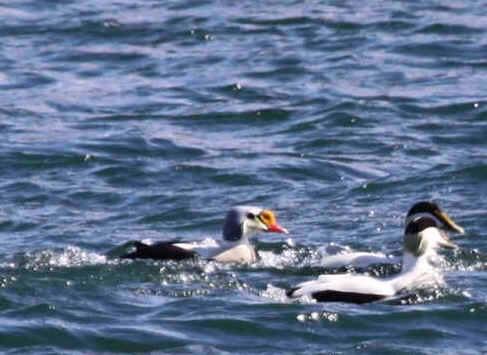
An adult male King Eider (left)
with Common Eiders (right)
during the FONT Iceland Tour in June 2015
(photo by Marie Gardner)
HERON
95. Grey Heron (ph) (*) Jun Sep
Oct
Ardea aquaticus
The Grey Heron is more often a winter visitor in Iceland, but
it can be found at other times of the year. Most of those that winter in Iceland
are immature birds from Norway.
In Iceland, the Grey Heron can either be solitary or in small groups. The
species can be seen all around Iceland at seashores, rivers, brooks, ponds, and
lakes that remain unfrozen, more often in the southern and southwestern parts of
the country.
COOT
96. Eurasian Coot (*) Jun
Fulica atra
WADERS (SHOREBIRDS)
97. Grey
(or
Black-bellied)
Plover (ph) (*) Jun Sep
Pluvialis squatarola
98. Northern Lapwing (ph)
Vanellus vanellus
99. Ruff / Reeve (ph)
Philomachus pugnax
The Ruff (male) / Reeve (female) is a rare but annual
visitor in Iceland, where it is most likely to be found in the spring. During
that season, it occurs mainly in Iceland at inland locations. In the autumn, it
occurs less frequently, and usually then along the
coast.
100. Jack Snipe
Lymnocryptes minimus
The Jack Snipe is a smaller version of the Common Snipe. Due
to its size, it has the nickname, "Half-Snipe".
The Jack Snipe is a rare winter visitor in Iceland, found at springs of
constant temperature, geothermal areas, and other places where water does not
freeze over.
A single Jack Snipe was by a warm brook near Selfoss, in southern
Iceland, in mid-January 2015. Another lone Jack Snipe waqs in southeast
Iceland, at Seljavellir/Nes on April 16, 2015.
Even though the Jack Snipe is seemingly an annual winter visitor in
Iceland, it is hard to see as it sits very still, and then crouches low, before
exploding into the air and usually landing some distance away.
Jack Snipes breed in northern coniferous woods and tundra of Eurasia.
101. Eurasian Curlew (*) Sep Oct
Numenius arquata
The Eurasian Curlew is a winter visitor to Icelandic
seashores. It is seen throughout the country, but most commonly in southwest
Iceland and at Hornfjordur in the southeast. Birds that come to Iceland for the
winter are from northern Europe, in Norway.
The Eurasian Curlew has also been found to be a rare breeder in Iceland,
with nests found at Melrakkasletta in the northeast.
102. Bar-tailed Godwit (ph) (*) Sep
Oct
Limosa
lapponica
The Bar-tailed Godwit is a somewhat irregular, but apparently
an annual visitor to Iceland, with a few occurring occasionally in the winter on
the seashores of southwestern Iceland and at Hornafjorour in southeast Iceland.
In Eurasia, the Bar-tailed Godwit is an Arctic breeder in northern
Scandinavia and eastward across the Siberian tundra.
SKUAS, GULLS
103. Pomarine Jaeger (or
Pomarine Skua) (ph) (*) Jun
Stercorarius
pomarinus
The Pomarine Jaeger is an Arctic bird, that passes through
Iceland on migration in the spring and autumn, between its breeding grounds
around the Arctic Ocean and its winter home in the South Atlantic Ocean. In
Iceland, it is generally observed along the coast or at sea.
Two color morphs of the Pomarine Jaeger occur. Light birds are far more
common than dark ones.
104. Long-tailed Jaeger (or Long-tailed Skua) (ph)
Stercorarius
longicaudus
The Long-tailed Jaeger is normally an Arctic bird that passes through Iceland as
a migrant in the spring and autumn, with its breeding grounds around the Arctic
ocean and its wintering range in the southern Atlantic Ocean.
Although generally observed in Iceland along the coast or at sea, Long-tailed
Jaegers occur inland more often than Pomarine Jaegers.
Two color morphs of the Long-tailed Jaeger occur. Light birds are far more
common than dark.
In the summer of 2008, Iceland's only pair of Long-tailed Jaegers, in the
northeast part of the country, raised one young.
105. Little Gull (ph) (*) Jun Sep
Larus
minutus
The Little Gull is an annual visitor in Iceland. It is seen during all
seasons, but especially in the early summer in colonies of Black-headed
Gulls.
In the summer of 2008, 2 young Little Gulls were raised in the Lake Myvatn area, reflecting
the first recorded breeding success of the species in Iceland. There was an
attempt to breed in the country in 2003, but the outcome was
uncertain.
106. Ivory Gull (ph)
Pagophila
eburnea
The Ivory Gull is an Arctic bird that is an annual visitor in Iceland
from northern, frozen areas. In Iceland, it is mainly seen in the
north.
Ivory Gulls generally follow the edge of pack ice in the ocean north of
Iceland. When the pack ice reaches Iceland, small groups of them may be seen.
Otherwise Icelandic sightings tend to be single birds.
An Ivory Gull was seen in northwest Iceland at Talknafjordur on April 30,
2015.
PIGEON, DOVES
107. Common Wood Pigeon
Columba palumbus
A Common Wood Pigeon was in eastern Iceland at Reydarfjordur on April 13,
2015.
One was at Hofn also in eastern Iceland on April 4-7, 2015.
One was at Berga/Nes in southeast Iceland on March 18, 2015
108. Eurasian Collared Dove
Streptopelia decaocto
A Eurasian Collared Dove was in southwest Iceland at Akranes on April 13,
2015, having been there for a while.
109. European Turtle Dove
Streptopelia turtur
OWLS
110. Northern Long-eared Owl (ph)
Asio otus
Generally, the Long-eared Owl is a visitor in Iceland, but not annually,
and usually found in the autumn and winter. The species is common in Europe and
America.
On Aug 7, 2008, there was news that a pair of Long-eared Owls raised 3 chicks in
southern Iceland.
111. Snowy Owl (ph)
Bubo
(formerly
Nyctea)
scandiacus
The Snowy Owl is normally a breeding bird of the Arctic tundra, breeding
in the most northerly countries of the world, including Greenland.
In earlier times, a Snowy Owl seen in Iceland was presumed to be a rare
visitor from Greenland, but in 1932 the first Snowy Owl nest discovered
in Iceland was found in rough terrain of the Odadaahraun region in the central
highlands. It was a large nest with 4 almost completely round white eggs,
similar in size to those of Gyrfalcons. The 2 large white parents were seen in
flight over a nearby lava field. Another Snowy Owl nest was found
in that region in June 1939. It contained 3 newly-hatched owlets. In the spring
of 1940, another 3 Snowy Owl nests were found. A search in 1945 also
ended with the finding of 3 Snowy Owl nests.
Snowy Owls may well have nested in the central highlands prior to 1932.
The areas where the nests were subsequently discovered are difficult to reach,
particularly so in the spring. By mid-summer, when the lava fields are more
reachable, the young would have become fully fledged and the owls would have
left their breeding grounds.
Breeding Snowy Owls were also discovered in the Odadhraun region in 1957
and around 1974, but according to our sources, no definite nests have been
recorded in Iceland since then.
In 1985, an expedition was made into the Odadahraun region to ascertain if the
Snowy Owl were breeding there. No nest, or evidence of breeding, was found,
but one Snowy Owl was sighted in the area.
Snowy Owls have been seen in Iceland just about annually during recent
years, but the birds could be vagrants from Greenland. Snowy Owls have
been seen in Iceland during every season.
The Snowy Owl is a wary bird. Areas where it is found in Iceland are
those with good vantage points for the bird.
In much of its range, Snowy Owls live largely on lemmings, but in Iceland
its main diet is probably birds, particularly Ptarmigans. The Snowy Owl
has also been said to seize fish from rivers and lakes with its
claws.
a SWIFT
112. Common Swift
Apus apus
PASSERINE BIRDS
113. Rook
Corvus frugilegus
The Rook, common on the European mainland, is a vagrant in Iceland,
usually annually. When they do occur in Iceland, their numbers vary. It
generally comes into the country in the autumn, either as solitary birds or in
small groups that might stay through the winter. The Rook is mainly seen
in southern Iceland, often in urban settings.
114. Western Jackdaw (ph)
Corvus monedula
The Western Jackdaw occurs as a vagrant in Iceland, either in the spring
or the fall. Numbers seem to peak in October. Sometimes it occurs in
groups.
The Western Jackdaw, a species which nests in buildings, has attempted a
few times to breed in Iceland, but young have not been raised.
115. Bohemian Waxwing
Bombycilla garrulus
A Bohemian Waxwing was in eastern Iceland at Stodvarfjordur on April 18,
2015.
116. European Robin (ph)
Erithacus rubecula
A fledgling European Robin was found in the summer of 2008, at Pingvellir,
indicating the 2nd or 3rd successful breeding of the species in
Iceland.
In the autumn of 2014, there was a bit of an influx of European
Robins in southeastern Iceland. East of Hofn, there were sightings at
4 locations:
Single birds were of at 2 of the places, 1 on October 8, 2014, 1 on
November 17, 2014. One was in Hofn on October 11, 2014.
A previous record in that section of Iceland was 1 bird on January 4, 2012.
At the two other locations in southeastern Iceland in the fall of
2014, there were sightings at Stodvarfjordur of 1 bird on October 8, 5 birds
on November 14, and 8 birds on November 17, and at Djupivdgur of 2 birds on
October 8 and 5 birds on November 17.
So the day with the maximum number in southeastern Iceland was November 17, 2014 with 13 birds at
the 2 locations.
In northeastern Iceland, there was 1 bird at 1 location on November 9,
2014. And further west, in Husavik, there was 1 European Robin
from November 11, 2014 through at least April 9, 2015.
Previous records in Husavik were single birds: October 14, 2008 to March
21, 2009, and January 16 to March 12, 2010, and October 9, 2010.
Another location in northeastern Iceland with records of European Robins
has been Melrakkasletta with single birds: October 8 & 14, 1995,
October 14 & 19, 1996, October 11, 1997, November 4, 2000, and October 31,
2010.
At 3 other places in northeastern Iceland there single birds on
April 2, 1994, January 2, 2001, and November 9, 2014.
At one of those places, Tjornes, there were 5 European Robins on November
3, 2010.
In southern Iceland, 1 European Robin was at a garden in Selfoss
the week of April 12-19, 2015, and prior to that in March.
Also in southern Iceland, there were 2 European Robins at Hvolsvollur on
November 3, 2014. 1 was there October 10, 2014
1 was at Vik on October 11, 2014.
On the Westmann Islands, in Heimey, 1 European Robin was present
November 19-27, 2014, two were there December 1-10, 2014, and 1 continued from
December 15, 2014 to April 13, 2015.
In southern Iceland, at the Hofdaskogur Forest, 1 European Robin
was seen April 7, 2015. Single birds were also seen there February 6, 2010 and
February 7, 2013.
At Eyjafjoll in southern Iceland, there was a single European Robin on
February 10, 2002.
In southwest Iceland, a single European Robin was at Akranes on March
26-30, 2015.
Much (but not all) of the info here about the European Robin in Iceland
is from e-bird reports.
117. Song Thrush
Turdus philomelos
A Song Thrush was at Hofn, in southeast Iceland, on April 14,
2015.
118. Brambling (ph) (*) Jun
Fringilla montifiringilla
The Brambling is a rare visitor in Iceland, mostly seen in the
autumn. In Iceland, it can be found singly or in a small flock. Sometimes in the
spring in Iceland, solitary singing males are found.
The Brambling has bred occasionally in various parts of Iceland. The number of
breeders has fluctuated. A Brambling was singing at Pingbellir on June 4,
2008.
119. Common Chaffinch
Fringilla coelebs
Less so than the Brambling, the Common Chaffinch occurs, on
occasion, in Iceland in the autumn, winter, and spring.
The Common Chaffinch has bred in Iceland several times, mainly in spruce trees. The
first confirmed breeding in Iceland was in 1986.
In southern Iceland, after having been seen in the Selfoss area in 1980, the Common
Chaffinch was not seen there again for years. But, now in 2015, 4 or
5 of them have been there, during the week of April 12-18, visiting a garden,
where they had been present since October 2014.
120. Eurasian Siskin (*) Jun
Sep Oct
Spinus
(formerly
Carduelis)
spinus
2008 was a big year in Iceland for Eurasian Siskins.
121. Red Crossbill (*) Oct
Loxia
curvirostra
The Red Crossbill has been known to have bred once in Iceland, in December
1994.
122. Garden Warbler
Sylvia borin
The Garden Warbler is one of the relatively common rarities in Iceland,
occurring in the autumn. It breeds in mainland Europe east to central
Asia.
123. Blackcap (*) Oct
Sylvia atricapilla
The Blackcap is the most common of the Old World Warblers that occur in
Iceland. It is an annual visitor in the autumn. The species is common in
mainland Europe, the Middle East, and northwest
Africa.
124. Common Chiffchaff
Phylloscopus
collybita
The Common Chiffchaff is the second most common of the Old World Warblers
in Iceland, where it occurs annually in the autumn. Actually, it can survive the
Icelandic winter. The bird feeds on the Green Spruce Aphid.
The Common Chiffchaff is a breeding bird in the woods of mainland Europe
and Asia.
125. Willow Warbler
Phylloscopus
sibilatrix
As is the Chiffchaff, the Willow Warbler is an annual visitor in
the autumn, but less commonly so. In Iceland, it is usually seen earlier in the
late-summer and early-fall season than the Chiffchaff.
The Willow Warbler is common in deciduous woodlands of mainland Europe
and northern Asia.
126. Goldcrest (ph) (*) Jun Sep
Oct
Regulus regulus
The Goldcrest has recently started to breed in Iceland, with the first proven
occurrence in 1999.
127. Lapland Longspur (or
Lapland Bunting)
Calcarius
lapponicus
Including accidentals on the "country
list".
The exact or approximate number of records (as of 2006, or later) is in
parentheses.
QUAIL
128. Common Quail (1)
Coturnix coturnix
The only Common Quail ever in Iceland was there on October 23,
1998.
WATERFOWL
129. Mute Swan (4)
Cygnus olor
Mute Swans were observed in Iceland on May 10, 1993, April 4 & May 17 & June 2,
1989, & June 18, 1998, August 3, 1996, & August 27, 2008.
130. "Bewick's" Tundra
Swan (22)
Cygnus columbianus
131. Bean Goose (59)
Anser fabalis
132. Ross' Goose (2)
Chen
(was Anser) rossii
A Ross' Goose in southern Iceland on April 14, 2015 was the 2nd
record for the country. That bird continued until at least May 3 at
Hyammur/Lon. Probably it was the same bird in eastern Iceland at Vofnafjordur on
May 16, 2015.
133. Red-breasted Goose (4) (ph)
Branta
ruficollis
Red-breasted Geese were in Iceland on April 25, 2004, May 7, 2007, May
1, 2013, April 12, 2015, with the most recent in southern Iceland. Maybe it
was the last of these that continued until at least May 6, 2015 at Adaldalur,
in northeast Iceland, in the company of Greylag Geese.
134. Cackling Goose (ph)
Branta
hutchinsii
A single Cackling Goose was in southeast Iceland on April 15,
2013.
135. Ruddy Shelduck (7)
Tadorna ferruginea
136. Wood Duck (5) (ph)
Aix sponsa
2 Wood Ducks were in Iceland on April 26, 1984. Also Wood Ducks
were in Iceland on April 15, 2006 & October 8, 1994.
137. Mandarin Duck (14-plus) (ph) (These wanderers from the introduced British population.)
Aix galericulata
138. Green-winged Teal (123-plus) (ph) (*) Jun
Anas carolinensis
139. Blue-winged Teal (11) (ph)
Anas discors
Blue-winged Teals
were at 3 locations in Iceland on September 22, 2011, 2 in the southwest, and 1
on the Westmann Islands.
140. Garganey (75) (*) Jun
Anas querquedula
A Garganey was in southwest Iceland from August 5 until at least August
12, 2011.
141. American Black Duck (31) (ph) (*) Sep
Oct
Anas rubripes
142. Lesser Scaup (5) (ph)
Aythya affinis
Lesser Scaups
were in Iceland on April 29, 2010, May 11, 2000, May 15, 2008, May 16, 1998 and
June 2, 2001.
143. Ring-necked Duck (58) (ph)
Aythya collaris
A drake Ring-necked Duck was in southern Iceland on September 11,
2011. A female Ring-necked Duck was in northwest Iceland, at Bolungarvik
on April 17, 2015, having been for a while in that area.
144. Redhead (2) (ph)
Aythya americana
A Redhead was in Iceland on June 15, 1998.
145. Canvasback (1)
Aythya
valisineria
A Canvasback was in Iceland on April 11, 1977.
146. Bufflehead (4) (ph)
Bucephala albeola
A Bufflehead was in Iceland on April 23, 2011 & May 15, 1998. The
April 2011 bird was a first-winter drake at Hafnir in southwest Iceland.
147. Velvet
Scoter (69)
Melanitta fusca
A drake Velvet Scoter was found in southwest Iceland on
October 16, 2001 (the same day that a White-winged Scoter was
found).
148. White-winged Scoter (*) Jun
(the North American species; was conspecific with the
Velvet Scoter)
Melanitta deglandi
A White-winged Scoter was in Iceland on May 20, 2006. An Asian White-winged
Scoter, Melanitta deglandi stejnegeri, was in Iceland on April 6,
2003.
A drake White-winged Scoter was found in southwest
Iceland on October 16, 2011.
More recently, an adult male White-winged Scoter was in southwest Iceland
from November 28, 2014 until March 30, 2015.
149. Surf Scoter (36-plus) (ph) (*) Jun
Melanitta perspicillata
A female Surf Scoter was in southwest Iceland at Porkotlustadir/Grinivik
on April 14, 2015, having been there for a while.
150. Steller's Eider (14) (ph)
Polysticta stelleri
A long-staying male Steller's Eider continued in northeast Iceland until
June 2013. The "long stay" in Iceland for that bird was about 15
years.
A female Steller's Eider was in northeast Iceland on July 30 & 31, 2008.
The long-staying male Steller's Eider, referred to above, was in northeast
Iceland from 1998 in the area of Borgarfjordur eystri (Bakkagerdi). It kept company with local Harlequin
Ducks. That Steller's Eider was, during most of the
year, in the sea by the village either in or near the harbor. When
the Harlequins would head up the river to the south of the village to breed, the
Steller's Eider would accompany them. That male Steller's Eider
continued in the area until June 2013, enjoying its life with
the Harlequins, as noted for a decade and a half.
151. Hooded Merganser (7) (ph)
Mergus cucullatus
A molting drake Hooded Merganser was at Lake Myvatn on August 29, 2008.
Also, Hooded Mergansers were in Iceland on May 6, 2007, May 21, 1994, May
23, 1998 & April 18 & May 30, 2003.
An adult male Hooded Merganser was in Reykjavik from November 18, 2014
through the winter, until April 2015 at lake Ellidavatn.
152. Smew (16-plus)
Mergus albellus
A drake Smew was in eastern Iceland, at Krosstjarnir/Fellabaer,
May 15-16, 2015.
153. Ruddy Duck (84) (ph) (A number of these wanderers are from the introduced British population.)
Oxyura jamaicensis
DIVER, ALBATROSS, STORM-PETREL, GREBES
154. Yellow-billed Loon
(or White-billed Diver) (*) Jun
Gavia adamsii
One was seen during our June 2006 Iceland Tour. Prior to that, the
Yellow-billed Loon was not on the official "Iceland List".
Unfortunately, it still is not, because even though we saw the bird well, a photograph was not obtained
as our sighting was when we were on a moving ferry from Flatey Island in
Breidajordur.
Subsequently, on August 17, 2011, the first documented Yellow-billed Loon
in Iceland was found in the Westmann Islands. It stayed until September
12.
Another Yellow-billed Loon was in eastern Iceland in December 2011 &
January 2012.
155. Arctic Loon
(or
Black-throated Diver) (*)
Gavia
arctica
Said to be the first for Iceland, an Arctic Loon was reported in the
western part of the island on February 24, 2012.
156. Black-browed Albatross (2) (ph)
Thalassarche melanophris
An unidentified albatross was seen in Icelandic waters on August 30, 2002.
157. Wilson's Storm Petrel (1) (ph)
Oceanites oceanicus
A Wilson's Storm Petrel was seen in Icelandic waters on August 11,
2007.
158. Pied-billed Grebe (3) (ph)
Podilymbus podiceps
The Pied-billed Grebe in Iceland on August 2, 2011 was the third
record for the country. The 2 previous records were on April 26, 2006 &
October 10, 1976.
159. Little Grebe (1) (ph)
Tachybaptus ruficollis
A Little Grebe was in Iceland on September 17, 2004.
160. Great Crested Grebe (7) (*) May
Podiceps cristalus
Great Crested Grebes
were in Iceland on September 14, 2002, & October 29, 1995.
161. Red-necked Grebe (43) (ph)
Podiceps grisegena
STORKS, SPOONBILL, IBIS
162. Black Stork (2) (ph)
Ciconia nigra
A Black Stork was in Iceland on June 10, 1996.
163. White Stork (4) (ph)
Ciconia ciconia
White Storks were in Iceland on March 27, 1975, April 24, 1969, &
October 22, 2002.
164. Eurasian Spoonbill (5) (ph)
Platalea leucorodia
Eurasian Spoonbills
were in Iceland on September 22, 2005, September 30, 1972, October 8, 1998,
& October 10, 11, 19, & 24, 2008.
165. Glossy Ibis (7-plus) (ph)
Plegadis falcinellus
A Glossy Ibis was in Iceland on October 6, 2005. More recently,
one was in southwest Iceland, at Osbotnar, on May 3, 2015.
BITTERNS, HERONS, EGRETS
166. Eurasian Bittern
(or
Great Bittern) (5)
Botaurus stellaris
An Eurasian Bittern was observed in Iceland on March 31 & April
14, 2004. The 5th Eurasian Bittern for Iceland was found on October
30, 2011 and continued through at least November 16.
167. American Bittern (6) (ph)
Botaurus lentiginosus
An American Bittern was in Iceland on October 8,
1989.
168. Least Bittern (1) (ph)
Ixobrychus exilis
A Least Bittern was in Iceland on September 17, 1970.
169. Little Bittern (2)
Ixobrychus minutus
Very unexpected was a juvenile Little Bittern in southwest
Iceland on October 16, 2011. It was the first live record for Iceland. The
previous record was of a bird washed ashore on May 20, 1823.
170. Black-crowned Night Heron (9) (ph)
Nycticorax nycticorax
Black-crowned Night Herons were in Iceland on April 10, 1993, May 15, 2006,
June 14, 1956, October 13, 2004, October 17, 1976, & November 2, 1980. Two Black-crowned Night Herons were observed on April 1,
1993.
171. Western Cattle Egret (6) (ph)
Bubulcus ibis
On November 1, 2011, the 5th Cattle Egret recorded in
Iceland was eaten by a Gryfalcon. The 6th Cattle Egret for Iceland
was found elsewhere that same day.
Previously, 2 Cattle Egrets were in Iceland on September 27, 2008.
172. Snowy Egret (3) (ph)
Egretta thula
Snowy Egrets were in Iceland on April 6, 1974 & June 6, 1983.
173. Little Egret (14) (ph)
Egretta garzetta
174. Great Egret (2) (ph)
Ardea alba
Great Egrets were in Iceland on April 5, 2002, April 27, 2008 & May 1,
2000.
175. Great Blue Heron (2)
Ardea herodias
A Great Blue Heron was in Iceland on April 6, 1984.
176. Purple Heron (2)
Ardea purpurea
Purple Herons
were in Iceland on May 3, 2011 & October 5, 1983.
177. Squacco Heron (1)
Ardeola ralloides
The only Squacco Heron in Iceland was there on April 19, 1969.
178. Green Heron (2) (ph)
Butorides virescens
Green Herons
were in Iceland on May 28, 2004, & October 29, 2001.
RAPTORS:
179. Common Kestrel (or
Eurasian Kestrel) (80) (*) Sep
Oct
Falco tinnunculus
180. Red-footed Falcon (4)
Falco vespertinus
Red-footed Falcons were in Iceland on April 18, 1985 and April 20,
1981.
181. Eurasian Hobby (17)
Falco subbuteo
A Eurasian Hobby was in southeast Iceland August 3 to 8, 2011.
182. Peregrine Falcon (16) (ph)
Falco peregrinus
183. Osprey (20) (ph)
Pandion haliaetus
184. European Honey Buzzard (5)
Pernis apivorus
European Honey Buzzards
were in Iceland on June 7, 1941 September 5, 1988, September 24, 2000,
& October 1, 1992..
185. Black Kite (3)
Milvus migrans
Black Kites
were in Iceland on April 11, 2003, October 21, 2001, & October 24,
1982.
186. Red Kite (1) (ph)
Milvus milvus
187. Eurasian Sparrowhawk (9-plus) (ph)
Accipiter nisus
Eurasian Sparrowhawks
were in Iceland on April 20, 1987, October 15, 2010, October 19, 1988,
& October 26. 1950. The
9th Eurasian Sparrowhawk for Iceland was found on October 30, 2011.
A Eurasian Sparrowhawk was at Hofn in southeast Iceland on December
10, 2014, and sightings of it, a female, continued until April 10, 2015.
In Friday, February 13, 2015, there were 2 Eurasian Sparrowhawks at Hofn.
Another was at Selfoss, in southern Iceland, December 30-31, 2014, and again
there January 12 - February 9, 2015.
Yet another Eurasian Sparrowhawk sighting was in southeast Iceland, at
Selberg/Nes on February 6, 2015.
188. Western Marsh Harrier (9)
Circus aeroginosus
Western Marsh Harriers were observed in Iceland on March 28 & April 12,
1993, and on May 2, 1994, May 13, 2006, September 13, 2006. & September 15,
1944.
189. Montagu's Harrier (3)
Circus pygargus
The 4th Montagu's Harrier for Iceland was a juvenile in the
northeast part of the country on August 24, 2011. Previously, a Montagu's
Harrier was in Iceland on September 27, 2002.
190. Hen Harrier (8) (not the Northern Harrier of North America)
Circus cyaneus
On June 11 & 12, 2008, a male Hen Harrier was seen doing display flights in
southern Iceland. Also Hen Harriers were in Iceland on May 19,
1974, October 15, 1957, & October 28, 2007.
191. Pallid Harrier (1)
Circus macrourus
The 1st Pallid Harrier for Iceland was found on September 14, 2011,
a juvenile. It continued to be seen until September 17.
192. Common Buzzard (4) (ph)
Buteo buteo
Common Buzzards
were in Iceland on March 22, 1998, May 21, 2004, June 17, 1982, September 13,
2008, & October 18, 2000.
193. Rough-legged Buzzard (or Rough-legged Hawk)
(16) (ph)
Buteo lagopus
194. Booted Eagle (1)
Hieraaaetus pennatus
The only Booted Eagle in Iceland was there on October 30,
1974.
CRAKES & ALLIES, CRANE
195. Spotted Crake (8) (ph)
Porzana porzana
Spotted Crakes
were in Iceland on September 30, 1979, October 13, 2004, & October 14,
1961.
196. Sora (1)
Porzana carolina
A Sora at Sudursveit, in southeast Iceland, April 25-27, 2011, was a
first record for Iceland.
197. Corncrake (32) (ph)
Crex crex
198. Common Moorhen (94) (ph)
Gallinula chloropus
A first-year Common, or Eurasian Moorhen was in
southwest Iceland at Astjorn/Hafnarfjordur on March 31, 2015, having been there
for a while.
199. Purple Gallinule (2) (ph) (not the Purple Swamphen of the Old World)
Porphyrio martinica
A Purple Gallinule was in Iceland on September 5, 1976.
200. American Coot (3) (ph)
Fulica americana
American Coots
were in Iceland on March 10, 1971, and October 16, 2004.
201. Common Crane (39-plus) (ph)
Grus grus
A Common Crane was in eastern Iceland, at Borgarfjordur, on May 4, 2015.
WADERS (or SHOREBIRDS)
202. Pied Avocet (5) (ph)
Recurvirostra avosetta
4 Pied Avocets were observed in Iceland on April 7, 2004. A single Pied
Avocet was observed in Iceland on March 31, 1954.
203. Semipalmated Plover (1) (ph)
Charadrius semipalmatus
The only Semipalmated Plover in Iceland was there on May 7, 2004.
204. Killdeer (3) (ph)
Charadrius vociferus
Killdeers
were in Iceland on March 16, 1939, & October 17, 1980.
205. Greater Sand Plover (1)
Charadrius leschenaultii
206. Eurasian Dotterel (2) (ph)
Charadrius morinellus
Eurasian Dotterels
were in Iceland on May 8, 1980, September 23, 1962, & October 8, 2007.
207. American Golden Plover (20) (ph)
Pluvialis dominica
An American Golden Plover was southwest Iceland on September
9, 2011. Later, 1 juvenile American Golden Plover was on the Westmann
Islands on September 24, 2011, and 2 adult American Golden Plovers
were in southwest Iceland that day. 1 was there on September 25,26 & 27. Then, 2 again on September 29.
1 was there the next day, on September 30, and 3 were there on October 1 to 3,
and then, 2 on October 4.
208. Pacific Golden Plover (1) (ph)
Pluvialis fulva
The 1st Pacific Golden Plover for Iceland was in the southwest part of
the country September 30 to October 2, 2011.
209. Spotted Redshank (10)
Tringa erythropus
Spotted Redshanks
were in Iceland on April 25, 1991, May 11, 2003, May 25, 1983, June 4, 1975, June 4,
1997, August 2, 2005, September 2, 1981, September 15, 2002, & September 16,
1988, & September 22, 1974.
210. Common Greenshank (18)
Tringa nebularia
211. Greater Yellowlegs (2)
Tringa melanoleuca
212. Lesser Yellowlegs (15) (ph)
Tringa flavipes
A Lesser Yellowlegs was in southwest Iceland September 4 to 13,
2011.
213. Upland Sandpiper (3)
Bartramia longicauda
Upland Sandpipers
were in Iceland on May 1, 1967 & May 3, 1974.
214. Common Sandpiper (10)
Actitis hypoleucos
Common Sandpipers
were in Iceland on May 7, 1964, May 14, 2003, May 20, 1966, May 21, 1989, May
22, 2002, June 4, 1963, and September 25, 1997.
215. Spotted Sandpiper (5) (ph)
Actitis macularius
Spotted Sandpipers
were in Iceland on April 28, 1963, September 3, 2005, September 14, 2007,
September 15, 1990, September 16 & October 14, 2007, & November 2, 1991.
216. Solitary Sandpiper (5) (ph)
Tringa solitaria
The 5th Solitary Sandpiper for Iceland was found in the southeastern part
of the country on September 4, 2011. Previously, there was a Solitary
Sandpiper in Iceland on August 2, 1940, August 19, 1995, & August 24,
1969.
217. Green Sandpiper (4)
Tringa ochropus
Green Sandpipers
were in Iceland on April 20, 2004 , April 28, 1986, May 7, 1988, June 4, 2007,
& September 5, 2010.
218. Wood Sandpiper (31) (ph)
Tringa glareola
The Wood Sandpiper has occasionally bred in Iceland in recent decades. Nests
have been found near Lake Myvatn in northern Iceland.
219. Curlew Sandpiper (62) (ph)
Calidris ferruginea
220. Little Stint (19)
Calidris minuta
221. Temminck's Stint (1)
Calidris temminckii
The only Temminck's Stint in Iceland was there on June 7,
2007.
222. Least Sandpiper (3) (ph)
Calidris minutilla
Least Sandpipers were in Iceland on August 9, 1978, August 19, 1971, September 23,
1990, & October 10, 2009.
223. Semipalmated Sandpiper (7) (ph)
Calidris pusilla
The 7th Semipalmated Sandpiper in Iceland was present in the
southeast part of the country August 29 to September 17, 2011. Previously, Semipalmated
Sandpipers were in Iceland on October 1, 1989, October 5, 1991, &
October 14, 2007.
224. Western Sandpiper (1) (ph)
Calidris mauri
Western Sandpipers were in Iceland on August 26, 1998, &
October 29, 2007.
225. White-rumped Sandpiper (78) (ph) (*) Oct
Calidris fuscicollis
226. Baird's Sandpiper (4) (ph)
Calidris bairdii
Baird's Sandpipers were in Iceland on August 30, 1996, September 3,
1994, September 14, 1996, & October 7, 2000..
227. Pectoral Sandpiper (46) (ph)
Calidris melanotos
A Pectoral Sandpiper was in the Westmann Islands on
September 3, 2011.
228. Buff-breasted Sandpiper (12) (ph)
Tryngites subruficollis
A Buff-breasted Sandpiper was in the Westmann Islands on
September 1, 2011. 3 Buff-breasted Sandpipers were in southwest Iceland
on September 24.
229. Broad-billed Sandpiper (5)
Limicola falcinellus
Broad-billed Sandpipers were in Iceland on May 24, 1987, May 25, 1985, June 19,
1989, & August 25, 1979.
230. Stilt Sandpiper (1) (ph)
Calidris himantopus
The only Stilt Sandpiper in Iceland was there on June 17, 1985.
231. Long-billed Dowitcher (10) (*) Sep
Limnodromus scolopaceus
2 Long-billed Dowitchers were in southwest Iceland September
17 to 21, 2011. while another, the 10th for Iceland, was also in the southwest
on September 20. Previously,
Long-billed Dowitchers were in Iceland on April 10, 2006, May
29, 1999, August 23, 1980, September 18, 2007, September 23, 2006, & October
19, 1980.
232. Wilson's Snipe (1) (ph)
Gallinago delicata
The only known Wilson's Snipe in Iceland was there on June 13, 2010.
233. Wilson's Phalarope (5)
Phalaropus tricolor
The 5th Wilson's Phalarope for Iceland was in the southwest part of
the country on September 5, 2011.Previously, Wilson's Phalaropes
were in Iceland on September 16, 1979, September 20 & 21, 1992, &
September 23, 1995.
234. Eurasian Stone-Curlew (1)
Burhinus oedicnemus
235. Collared Pratincole (1)
Glareola pratincola
The only known Collared Pratincole in Iceland was there on June 7,
1997.
236. Black-winged Pratincole (3)
Glareola nordmanni
Black-winged Pratincoles
were in Iceland on June 11, 1987, October 7, 1979, & October 8, 1083.
GULLS
and
TERNS
237. Ring-billed Gull (99-plus)
Larus delawarensis
A Ring-billed Gull was found at Grindavik in southwest Iceland on
March 22, 2015.
238. Yellow-legged Gull (3) (ph)
Larus michahellis
A third-summer Yellow-legged Gull was at Heimaey, on the Westmann
Islands on May 6, 2011. Also, a Yellow-legged Gulls have been in Iceland
on April 21, 1995, May 1, 2010, & August 25, 2000.
239. Thayer's Gull (3)
Larus thayeri
Thayer's Gulls were in Iceland on February 25, 2012 9at Hofn), March 2 & 12, 2005, March 10 & April 3, 2004 & April 8,
2006, & August 31, 2010.
240. Slaty-backed Gull (1) (ph)
Larus
schistisagus
The first Slaty-backed Gull for Iceland was found in Husavik in the
north on May 14, 2012.
241. Glaucous-winged Gull (1)
Larus
glaucescens
A Glaucous-winged Gull at Reykjavik harbor from January 30 to at
least February 5, 2015 was either the 1st or 2nd for Iceland.
242. Laughing Gull (15) (ph)
Leucophaeus
(formerly
Larus)
atricilla
A Laughing Gull was at Hofn in southeast Iceland on December 16,
2011, in company with an Ivory Gull.
243. Franklin's Gull (3) (ph)
Leucophaeus
(formerly
Larus)
pipixcan
Franklin's Gulls
were in Iceland on June 19, 1997, September 21, 1984, & September 29,
1992.
244. Bonaparte's Gull (20) (ph)
Chroicocephalus
(formerly
Larus)
philadelphia
245. Mediterranean Gull (1) (*) Sep
Ichthyaetus
melanocephalus
Most of the gulls at the glacial ice at Jokulsarlon, in eastern Iceland, during
the FONT tour on September 29, 2013 were Black-headed Gulls.
But one was a first-winter Mediterranean Gull, a first for Iceland.
246. Sabine's Gull (67) (ph) (*) Sep
Xema sabini
247. Ross' Gull (44-plus) (ph)
Rhodostethia rosea
A first-summer Ross' Gull was in southern Iceland at Stokkseyri on
May 16 & 17, 2015.
248. Gull-billed Tern (2) (ph)
Gelochelidon nilotica
Gull-billed Terns
were in Iceland on April 21, 1987 & September 25, 1999.
249. Sandwich Tern (15) (ph)
Thalasseus sandvicensis
250. Common Tern (4)
Sterna hirundo
Common Terns
were in Iceland on June 8, 2005 & September 25, 1999.
251. Forster's Tern (1) (ph)
Sterna forsteri
A Forster's Tern was in Iceland on October 22, 1959.
252. Little Tern (1)
Sternula albifrons
The only Little Tern in Iceland was there on June 10, 2006.
253. Sooty Tern (1) (ph)
Onychoprion fuscata
The only Sooty Tern in Iceland was there on June 12, 1969.
254. Whiskered Tern (2) (ph)
Chlidonias hybrida
A Whiskered Tern was in Iceland on April 24, 1987.
255. Black Tern (46) (ph)
Chlidonias niger
256. White-winged Tern (11) (ph) (*) Jun
Childonias leucopterus
A White-winged Black Tern was in southeast Iceland August 8
to 16, 2011.
ALCID
257. Crested Auklet (1)
Aethia cristatella
DOVES
258. Stock Dove (2)
Columba oenas
Stock Doves were observed in Iceland on April 20, 2003, and on April 21 and
May 1, 2007.
259. Mourning Dove (1) (ph)
Zenaida macroura
A Mourning Dove was in Iceland on October 18, 1995.
CUCKOOS
260. Common Cuckoo (45)
Cuculus canorus
261. Black-billed Cuckoo (2)
Coccyzus erythropthalmus
A Black-billed Cuckoo was in Iceland on October 21, 1982.
262. Yellow-billed Cuckoo (3)
Coccyzus americanus
Yellow-billed Cuckoos
were in Iceland on October 5, 1954, & October 13, 1987.
OWL, NIGHTJAR, NIGHTHAWK
263. Eurasian Scops Owl (5)
Otus scops
A
Eurasian Scops Owl was noted in Iceland on April 20 & May 31, 1960.
264. Eurasian Nightjar (2)
Caprimulgus europaeus
Eurasian Nightjars
were in Iceland on June 17, 1977 & October 25, 1933.
265. Common ("American") Nighthawk (1)
Chordeiles minor
A Common Nighthawk was in Iceland on October 23, 1955.
SWIFT
266. Alpine Swift (4)
Apus melba
An Alpine Swift was in southern Iceland on August 6, 2011. Previous
occurrences were on April 15, 1980, May 2, 2002, & June
16, 1981.
KINGFISHER, BEE-EATER, ROLLER, HOOPOE
267. Belted Kingfisher (5) (ph)
Megaceryle alcyon
A Belted Kingfisher was observed in Iceland on May 17 & June 18, 1998.
Another Belted Kingfisher was in Iceland on October 10, 2003.
268. European Bee-eater (2) (ph)
Merops apiaster
A European Bee-eater at Siglufjordur in northern Iceland, on May 15,
2011, was the 2nd record for the country. Previously, a European
Bee-eater was in Iceland on June 8, 1989.
269. European Roller (3)
Coracias garrulus
European Rollers were in Iceland on September 6, 1988 & September 11,
1964.
270. Eurasian Hoopoe (11)
Upupa epops
Eurasian Hoopoes were observed in Iceland on April 16, 1969, April 20 &
May 3, 2009, June 2, 1963, August 31, 1942, September 2, 2009, September 5,
1951, September 17, 1901, October 1, 2006, October 2, 1910, & October 8,
1993..
WOODPECKERS
271. Great Spotted Woodpecker (8) (ph)
Dendrocopos major
Great Spotted Woodpeckers
were in Iceland on September 28 & 29, 1953, October 23, 1968, &
October 24 & 25, 1999.
272. Yellow-bellied Sapsucker (2) (ph)
Sphyrapious varius
Yellow-bellied Sapsuckers were in Iceland on June 5, 1961 and October 7-13,
2007. The bird seen October 7-13, 2007 was in a garden in Selfoss, in
southern Iceland.
It was the second for Iceland, and the first ever seen there alive. The first,
in 1961, in southeastern Iceland, was found dead.
273. Eurasian Wryneck (13)
Jynx torquilla
TYRANT FLYCATCHERS
274. Acadian Flycatcher (1)
Empidonax virescens
275. Least Flycatcher (1)
Empidonax minimus
A Least Flycatcher was in Iceland on October 6, 2003.
276. Alder Flycatcher (1)
Empidonax alnorum
An Alder Flycatcher was in Iceland on October 10, 2003.
SHRIKES
277. Red-backed Shrike (13) (ph)
Lanius collurio
278. Great Gray (or Northern) Shrike (8) (ph)
Lanius excubitor
Great Grey Shrikes were in Iceland on April 29, 1978, May 4, 1966, October 12,
2009, & October 20, 1982. The 8th Great Grey Shrike for Iceland was found on October 30,
2011.
279. Woodchat Shrike (1)
Lanius senator
A Woodchat Shrike was in Iceland on May 12, 1970.
VIREO
280. Red-eyed Vireo (22)
Vireo olivaceus
2 Red-eyed Vireos were in southwest Iceland September 21-23,
2011. One was in southeast Iceland on October 3, 2011.
Previously, Red-eyed
Vireos were in Iceland on September 16, 1951, September 27, 1973, September
28, 2008, September 28, 2009, September 29 & October 6, 1996, October 1
& 4 & 7, 1997, October 4, 1978, October 6, 1996, October 8, 1997,
October 18, 1995, October 20, 1985, & October 20 & 27, 1995. Two
Red-eyed Vireos were in Iceland on September 30, 1997 & on October 22,
1995.
OLD WORLD ORIOLE
281. Eurasian Golden Oriole (12)
Oriolus oriolus
Eurasian Golden Orioles were in Iceland on May 20, 1957, May 25, 1976, June
3, 1994, June
5, 1988, June 9, 1972, September 10, 1960, & October 1, 1987..
CORVID
282. Hooded Crow (88)
Corvus corone cornix
WAXWING
283. Cedar Waxwing (2) (ph)
Bombycilla cedrorum
A Cedar Waxwing was in Iceland on October 8, 2003.
PARIDS
284. Northern Great Tit (5)
Parus major
Northern Great Tits were in Iceland on March 11, 1989 & March 14,
1977.
More recently, 2 Northern Great Tits were in eastern Iceland from
November 2 to at least December 13, 2014.
On April 30, 2015, a Northern Great Tit was at Nesskaupsstadur in eastern
Iceland.
SWALLOWS
285. Tree Swallow (1) (ph)
Tachycineta
bicolor
The first Tree Swallow for Iceland was in the Reykjavik
area (at Helluvatn) May 15-17, 2012.
286. Sand Martin (or Bank Swallow) (30)
Riparia riparia
287. Red-rumped Swallow (2)
Cecropis daurica
Red-rumped Swallows were in Iceland on June 3, 1988 & May 30,
2004.
288. American Cliff Swallow (3)
Petrochelidon (formerly Hirundo) pyrrhonota
Single American Cliff Swallows were in Iceland on October 12,
1992 & October 12, 2004.
LARKS
289. Greater Short-toed Lark (3)
Calandrella brachydactyla
A Greater Short-toed Lark was in Iceland on October 24,
1944.
290. Eurasian Skylark (107)
Alauda arvensis
291. Horned Lark (or Shore Lark) (1)
Eremophila alpestris
OLD WORLD WARBLERS
292. Lanceolated Warbler (1)
Locustella lanceolata
A Lanceolated Warbler was in Iceland on October 9, 1983.
293. Common Grasshopper Warbler (2)
Locustella naevia
A Common Grasshopper Warbler was in Iceland on May 19, 1951.
294. River Warbler (2)
Locustella fluviatalis
River Warblers
were in Iceland on June 10, 2008, October 4, 1974, & October 11, 2007.
295. Sedge Warbler (10)
Acrocephalus schoenobaenus
296. Blyth's Reed Warbler (7)
Acrocephalus dumetorum
The 7th Blyth's Reed Warbler for Iceland was found in the southeastern
part of the country on September 18, 2011. Previously, Blyth's Reed Warblers
were seen in Iceland on September 13 & October 15, 2002, & October 16,
2004. Two Blyth's Reed Warblers were in Iceland on October 17,
2003.
297. Marsh Warbler (12)
Acrocephalus palustris
298. Eurasian Reed Warbler (13)
Acrocephalus scirpaceus
A Eurasian Reed Warbler was in southwest Iceland on October 28-29, 2011.
299. Paddyfield Warbler (1)
Acrocephalus agricola
A Paddyfield Warbler was in Iceland on September 18, 2004.
300. Sykes's Warbler (1)
Hippolais rama
A Sykes's Warbler was in Iceland on September 14, 2002.
301. Icterine Warbler (8)
Hippolais icterina
Icterine Warblers
were in Iceland on June 3, 1967, June 20, 1992, August 10, 2004, September 7,
2004, September 10, 2004, September 16, 2006, & September 17, 2004, &
September 18, 2002.
302. Melodious Warbler (1)
Hippolais polyglotta
A Melodious Warbler was in Iceland on October 4, 1987.
303. Eastern Olivaceous Warbler (2)
Hippolais pallida
In September 2008, there was the first occurrence of the Eastern Olivaceous Warbler in Iceland.
Later, there was one on September 15, 2009.
304. Subalpine Warbler (2)
Sylvia cantillans
Subalpine Warblers
were in Iceland on May 26, 1992 & September 29, 1996.
305. Barred Warbler (112)
Sylvia nisoria
A Barred Warbler was in southeast Iceland on September 10, 2011.
306. Common Whitethroat (37)
Sylvia communis
307. Lesser Whitethroat (182)
Sylvia curruca
3 Lesser Whitethroats were in southeast Iceland on September 20,
2011. 1 was there on September 22.
308. Arctic Warbler (3)
Phylloscopus borealis
Arctic Warblers
were in Iceland on September 18, 1999, September 22, 1996. & September
30, 2004..
309. Wood Warbler (59)
Phylloscopus sibilatrix
310. Yellow-browed Warbler (103) (ph)
Phylloscopus inornatus
311. Dusky Warbler (1)
Phylloscopus fuscatus
The 1st Dusky Warbler for Iceland was found on October 28,
2011.
KINGLET, NUTHATCH
312. Ruby-crowned Kinglet (2) (ph)
Regulus calendula
A Ruby-crowned Kinglet was in Iceland on October 19, 1998.
313. Red-breasted Nuthatch (1) (ph)
Sitta canadensis
The only Red-breasted Nuthatch in Iceland was there on May 21, 1970.
STARLING
314. Rosy Starling (31) (*) Oct
Sturnus roseus
THRUSHES
315. Wood Thrush (1)
Hylocichia mustelina
The only Wood Thrush ever in Iceland was there on October 23,
1967.
316. Hermit Thrush (10)
Catharus guttatus
Hermit Thrushes
were in Iceland on September 26, 1986, October 13, 2005, October 14, 2009,
October 15, 1986, October 15, 2000, October 20, 1985, October 24, 1992, &
October 26, 1957.
317. Swainson's Thrush (4)
Catharus ustulatus
Swainson's Thrushes
were in Iceland on September 27, 1995, September 27, 2009, September 30, 2005,
October 9, 1996, & October 14, 1978.
318. Gray-cheeked Thrush (4)
Catharus minimus
Gray-cheeked Thrushes
were in Iceland on October 17, 2005, & October 30, 1983.
More recently, a Gray-cheeked Thrush was found in Iceland on November 2,
2014.
319. Ring Ouzel (38) (ph)
Turdus toquatus
320. Black-throated Thrush (1)
Turdus ruficollis
321. American Robin (5)
Turdus migratorius
American Robins
were in Iceland on March 14, 1958, October 6, 2003, October 13, 2001, October 18,
2008, & October 28, 1969, and November 15 & 17, 2011.
322. Mistle Thrush (46-plus)
Turdus viscivorus
323. Varied Thrush (1) (ph)
Ixoreus (formerly Zoothera) naevia
The only Varied Thrush in Iceland was seen there on May 3, 2004.
324. White's (Ground) Thrush (4)
Zoothera dauma
White's Thrushes
were in Iceland on October 9, 1982, & October 14, 1939. One in
southeast Iceland that was taken into care on November 26, 2011 subsequently
died.
CHATS
and OLD WORLD FLYCATCHERS
325. Bluethroat (17) (ph)
Luscinia svecica
326. Siberian Rubythroat (1) (ph)
Luscinia calliope
327. Thrush Nightingale (2)
Luscinia luscinia
Thrush Nightingales were in Iceland on October 15, 2002, & November 2, 2004.
328. Common Nightingale (13)
Luscinia megarhynchos
The 13th Common Nightingale for Iceland was seen in the northeast
part of the country on October 15, 2011.
329. Black Redstart (28) (ph)
Phoenicurus ochruros
330. Common Redstart (104)
Phoenicurus phoenicurus
331. Whinchat (121)
Saxicola rubetra
332. Eurasian Stonechat (20)
Saxicola torquatus
333. Spotted Flycatcher (112)
Muscicapa striata
A Spotted Flycatcher was in northeast Iceland on October 8,
2011.
334. European Pied Flycatcher (82)
Ficedula hypoleuca
A European Pied Flycatcher was in southeast Iceland on October
18,19 & 23, 2011.
335. Red-breasted Flycatcher (25)
Ficedula parva
OLD WORLD SPARROWS, ACCENTORS
336. Eurasian Tree Sparrow (6)
Passer montanus
Eurasian Tree Sparrows were in Iceland on May 22, 1976, May 25, 1959, &
October 5, 1995.
337. Dunnock (or Hedge Accentor) (29)
Prunella modularis
PIPITS
and WAGTAILS
338. Tree Pipit (21)
Anthus trivialis
339. Eurasian Rock Pipit (24-plus)
Anthus petrosus
340. Tawny Pipit (1)
Anthus campestris
The only Tawny Pipit in Iceland was was there on October 27, 1947.
341. Olive-backed Pipit (1) (ph)
Anthus hodgsoni
An Olive-backed Pipit was in Iceland on November 2, 2004.
342. Pechora Pipit (1)
Anthus gustavi
A Pechora Pipit was in Iceland on October 9, 1967.
343. Buff-bellied (or American) Pipit (10)
(ph)
(*) sep
Anthus rubescens
Buff-bellied
(or American) Pipits were in Iceland on
April 24, 1993, & September 16, 2000, September 19, 2007, September 27,
2009, September 28, 2008, October 2, 2005, October 5, 1983, October 7 & 9,
2004, October 11, 2007, October 11, 2009, October 16, 1977, October 20, 2007,
& October 21, 1989. Three Buff-bellied Pipits were in Iceland on September 20,
2008 & September 21, 2009 & 2 on
September 24, 2009.
344. Yellow Wagtail (including "Grey-headed" Yellow Wagtail)
(21)
Motacilla flava
345. Citrine Wagtail (10)
Motacilla citreola
Citrine Wagtails
were in Iceland on September 3, 1997, September 11, 1994, September 14
& 21, 2006, October 4, 2003, October 8, 1998, October 20, 1990, October 29,
1982, & October 31, 1973.
346. Grey Wagtail (36)
Motacilla cinerea
A Grey Wagtail was seen in Iceland on October 27, 2011.
FINCHES
347. European Greenfinch (8)
Chloris (has been
Carduelis)
chloris
European Greenfinches were observed in Iceland on March 22, 1997, April 17 & May 3,
2008, April 25, 1998, May 5, 1998, May 7, 2010, May 22, 2006, June 1, 2005,
& November 1, 2006.
348. European Goldfinch (10)
Spinus
(has been Carduelis)
carduelis
The 10th European Goldfinch for Iceland was in the southeast part of the
island on October 26, 2011. Previously, European Goldfinches
were in Iceland on October 12, 2006, & October 17, 2005. Two European
Goldfinches were in Iceland on October 13, 2006.
349. Arctic
(or Hoary) Redpoll (18) (*)
sep
Acanthis
(has been Carduelis)
hornemanni
An Arctic Redpoll was in southeast Iceland on October 19, 2011.
2 Arctic Redpolls, Acanthis hornemanni hornemanni, the "Hornemann's,
or Greenland Redpoll". were seen during the FONT Iceland Tour on September
26, 2013 in Reykjavik.
More recently, an Arctic Redpoll, Acanthis hornemanni hornemanni,
was in northern Iceland at Husavik on March 16, 2015, following a different
bird there on March 12.
One was at Selfoss in southern Iceland on March 11, 2015.
350. Common Linnet (2)
Carduelis cannabina
Common Linnets were in Iceland on April 24, 2005, & October 18, 2001.
351. Common (or Scarlet) Rosefinch (82)
Carpodacus erythrinus
A Common Rosefinch was in eastern Iceland on August 17, 2011.
352. Parrot Crossbill (5)
Loxia pytyopsittacus
Parrot Crossbills
were seen in Iceland on September 28 & October 14, 1962. Two
Parrot Crossbills were observed on October 5, 1962.
353. White-winged (or Two-barred) Crossbill (1)
Loxia leucoptera
A White-winged Crossbill was in Iceland on August 6, 2009.
354. Eurasian Bullfinch (190)
Pyrrhula pyrrhula
The largest number of Eurasian Bullfinches in Iceland was in the
autumn of 1994, and into the winter.
During that winter, there were 40 to 50 spotted throughout the country.
355. Hawfinch (24-plus)
Coccothraustes coccothraustes
A Hawfinch was in southeast Iceland, at Hofn, May 5-10, 2015.
NEW WORLD WARBLERS
356. Black-and-white Warbler (2)
Mniotilta varia
Black-and-white Warblers
were in Iceland on September 1, 1970, October 19, 1991.
357. Tennessee Warbler (1) (ph)
Oreothlypis
(formerly
Vermivora)
peregrina
The only Tennessee Warbler in Iceland was there on October 14,
1956.
358. Northern Parula (8) (ph)
Setophaga
(formerly
Parula)
americana
The Northern Parula in southwest Iceland September 19-20, 2011 was
the 8th for Iceland, and the first since 1989. In 1989, the Northern Parula
was in Iceland on September 27 & 29.
Also, Northern Parula occurred
in Iceland on October 8, 1962, October 21, 1948, October 24, 1957, October 25,
1913, & October 28, 1952.
359. Yellow Warbler (3) (ph)
Setophaga
(formerly
Dendroica)
petechia
Yellow Warblers
were in Iceland on August 25, 2000, September 10, 2003, October 5, 1996,
& October 11, 2009.
360. Cerulean Warbler (t3) (1)
Setophaga
(formerly Dendroica) cerulea
A Cerulean Warbler was in Iceland on October 1, 1997.
361. Black-throated Blue Warbler (2)
Setophaga
(formerly
Dendroica)
caerulescens
Black-throated Blue Warblers
were in Iceland on September 14, 1998, & October 17, 2003.
362. Black-throated Green Warbler (1) (ph)
Setophaga
(formerly
Dendroica)
virens
A Black-throated Green Warbler was see in Iceland on October 27,
2003.
363. Blackburnian Warbler (1) (ph)
Setophaga
(formerly
Dendroica)
fusca
364. Magnolia Warbler (2) (ph)
Setophaga
(formerly
Dendroica)
magnolia
Magnolia Warblers
were in Iceland on September 29, 1995, & October 21, 1995.
365. "Myrtle" Yellow-rumped Warbler (14) (ph)
Setophaga
(formerly
Dendroica)
coronata
A "Myrtle" Yellow-rumped Warbler was in Iceland on
September 25, 1993, & October 1, 1989. Two were there on September 26,
1980.
Other Yellow-rumped Warblers were in Iceland on October 10, 11
& 13, 1976, October 10, 1999, October 13, 1991, October 16, 1996, October 17,
2005, October 19, 1996, October 21, 2001, October 24, 2009, & October 25,
1964.
366. Palm Warbler (1)
Setophaga
(formerly
Dendroica)
palmarum
A Palm Warbler was in Iceland on October 5, 1997.
367. Blackpoll Warbler (13) (ph)
Setophaga
(formerly
Dendroica)
striata
Blackpoll Warblers
were in Iceland on September 28, 1972, October 7, 1995, October 13, 2009, October 16 &
17 & 23,
2005, October 18 & 22, 1974, October 23, 1979, October 28, 2001, &
October 30, 1975.
2 Blackpoll Warblers were in Iceland on
October 18, 2005.
368. American Redstart (1) (ph)
Setophaga ruticilla
An American Redstart was in Iceland on September 10, 1975.
369. Common Yellowthroat (3) (ph)
Geothlypis trichas
The 3rd Common Yellowthroat for Iceland was seen October 26-29, 2011.
Previously, a Common Yellowthroat was in Iceland on September 26, 1997.
370. Canada Warbler (1) (ph)
Cardellina
(formerly
Wilsonia)
canadensis
A Canada Warbler was in Iceland on September 29, 1973.
NEW WORLD
ORIOLES and
BLACKBIRDS
371. Baltimore Oriole (4) (ph)
Icteus galbula
Baltimore Orioles
were in Iceland on October 7, 2003, October 8. 1956, & October 15,
1971.
372. Yellow-headed Blackbird (1) (ph)
Xanthocephalus xanthocephalus
SPARROWS
and
BUNTINGS
373. White-throated Sparrow (5)
Zonotrichia albicollis
A White-throated Sparrow was in Iceland on June 10, 1964 & June
18, 1974.
374. White-crowned Sparrow (1) (ph)
Zonotrichia leucophrys
A White-crowned Sparrow was in Iceland on October 4, 1978.
375. Fox Sparrow (1) (ph)
Passerella iliaca
376. Dark-eyed Junco (1) (ph)
Junco hyemalis
377. Yellowhammer (14) (ph)
Emberiza citrinella
378. Pine Bunting (1)
Emberiza leucocephalos
The only Pine Bunting ever in Iceland was there on October 30,
1944.
379. Little Bunting (7)
Emberiza pusilla
Little Buntings
were in Iceland on May 8, 1988, October 3, 1992, October 26, 1996, &
October 30. 1980.
380. Rustic Bunting (4)
Emberiza rustica
Rustic Buntings were in Iceland on May 28, 1966, May 28, 1995, October
2, 1976, October 28, 1991, & October 31, 2009.
381. Reed Bunting (22)
Emberiza schoenictus
A male Reed Bunting on May 17, 2011 was the first record for the
species in western Iceland.
382. Ortolan Bunting (6)
Emberiza hortulana
Ortolan Buntings were in Iceland on May 22, 1969, May 26, 1957, September
27, 1992, September 30, 1968, October 11, 1976, & October 15, 1939.
383. Yellow-breasted Bunting (1)
Emberiza aureola
A Yellow-breasted Bunting was in Iceland on September 22, 1978.
384. Black-headed Bunting (3)
Emberiza melanocephala
A Black-headed Bunting was in Iceland on September 15,
1990.
TANAGER, GROSBEAK,
BUNTING
385. Scarlet Tanager (4) (ph)
Piranga olivacea
Scarlet Tanagers
were in Iceland on October 7, 1967 & October 23, 1967.
386. Rose-breasted Grosbeak (1) (ph)
Pheucticus ludovicianus
A Rose-breasted Grosbeak was in Iceland on October 20, 2001.
387. Indigo Bunting (2) (ph)
Passerina cyanea
Indigo Buntings
were in Iceland on October 20, 1985 & October 27, 1951.
Top of page